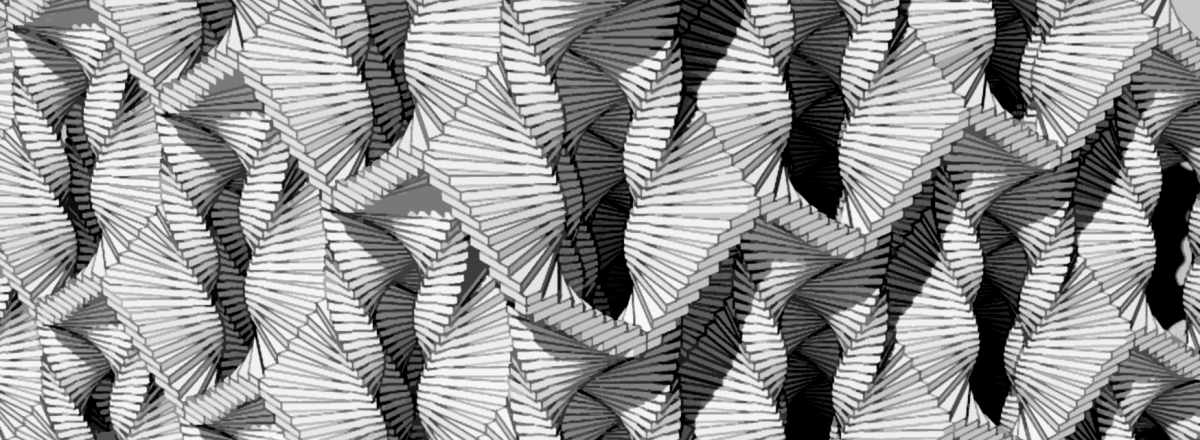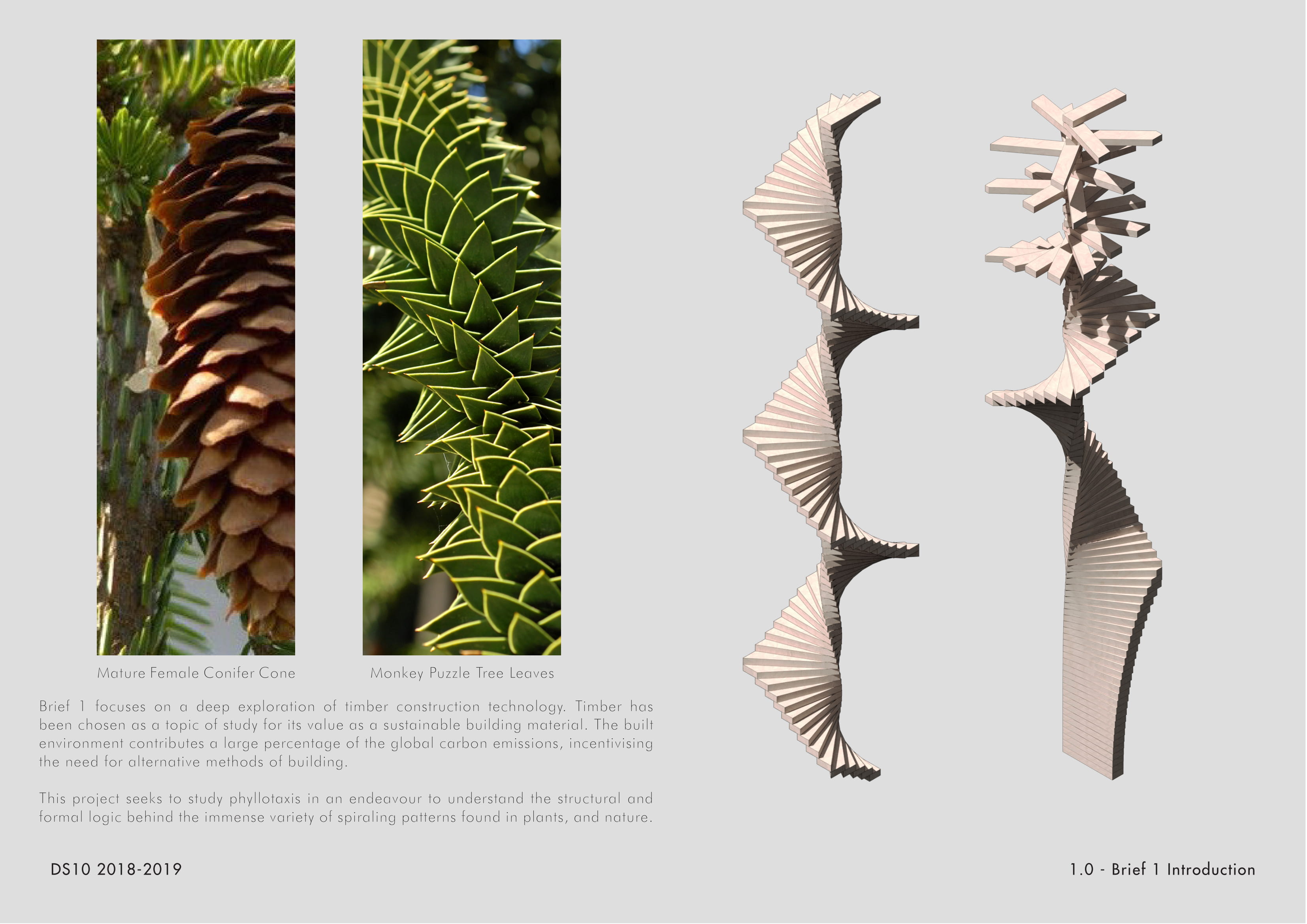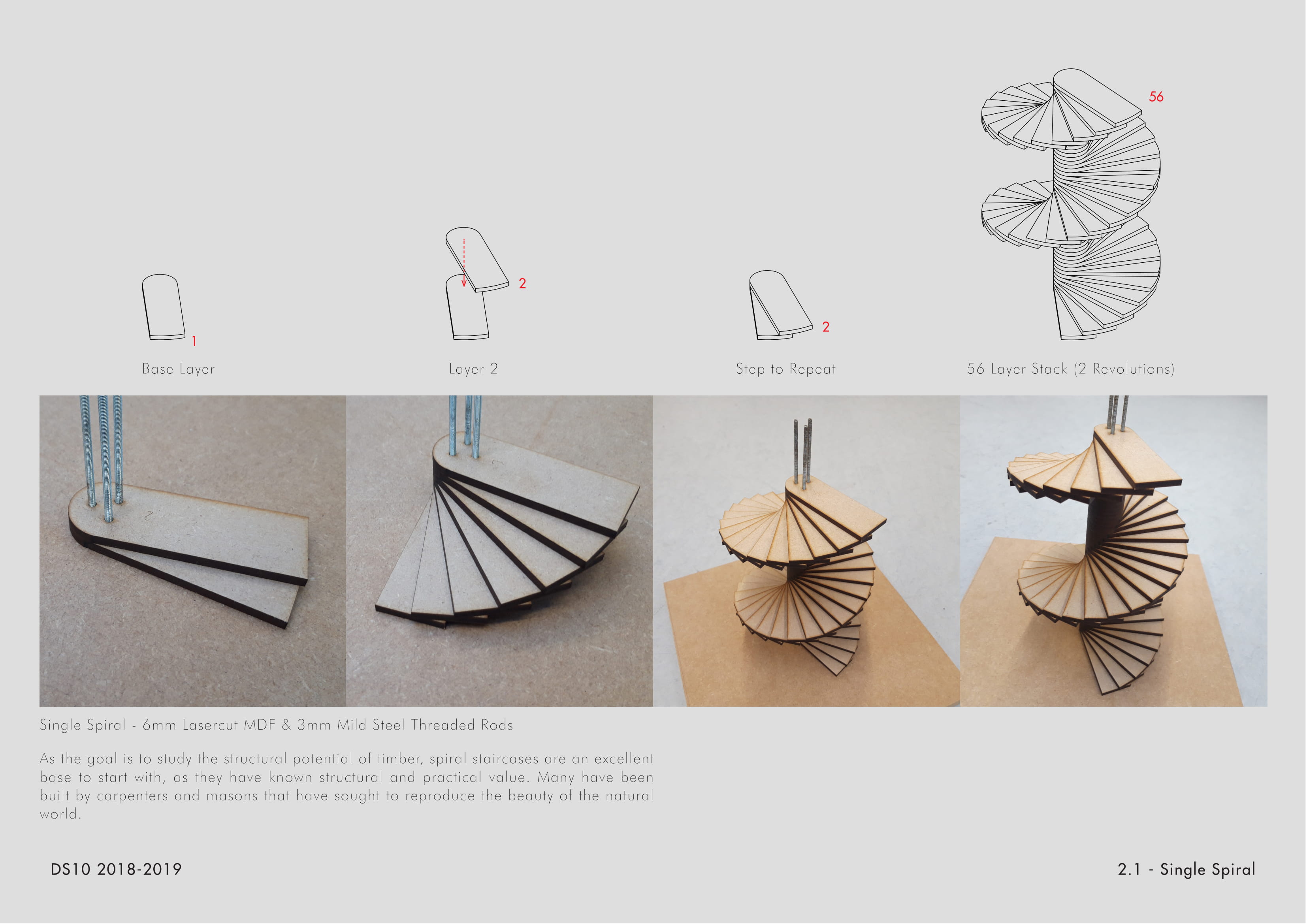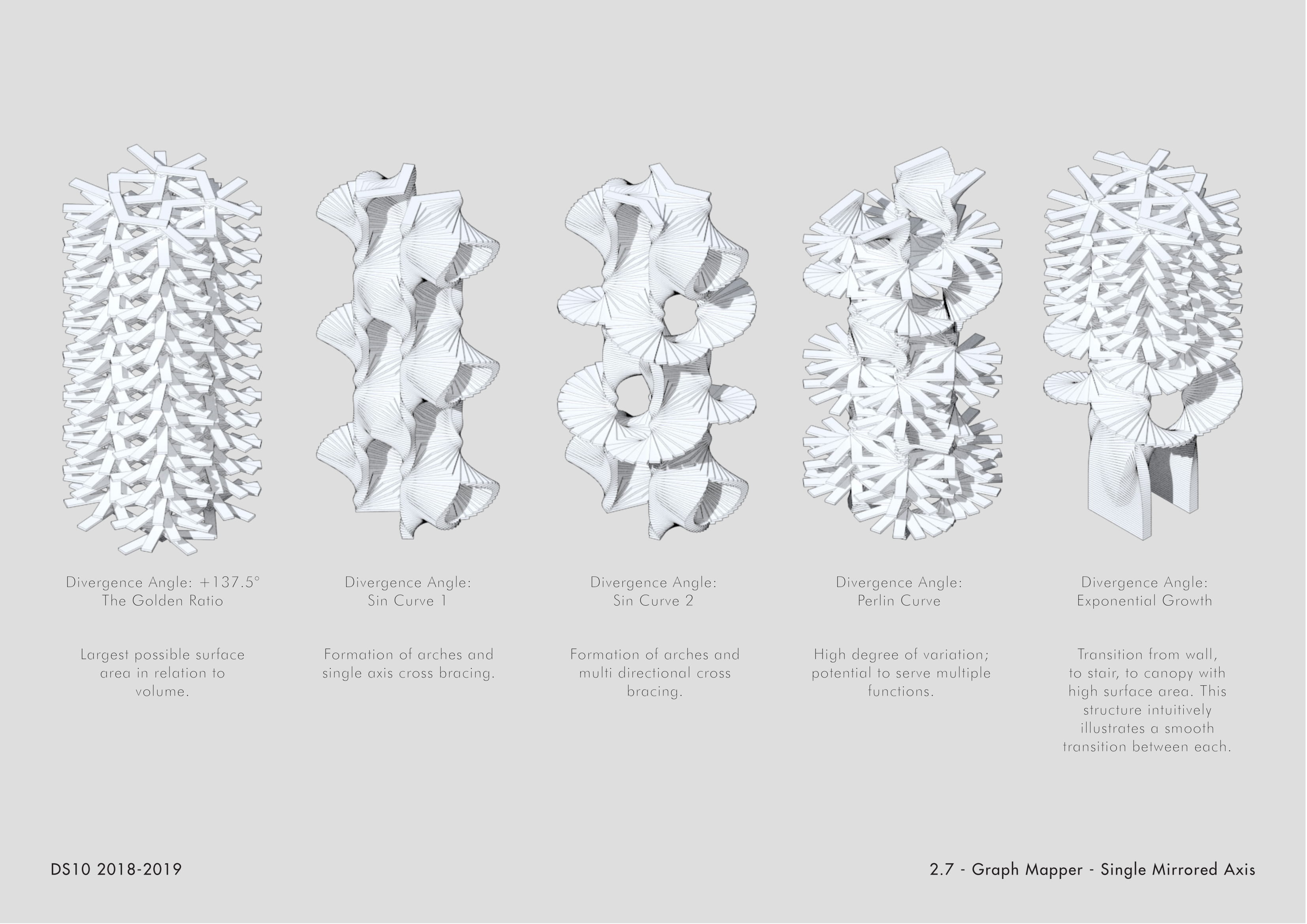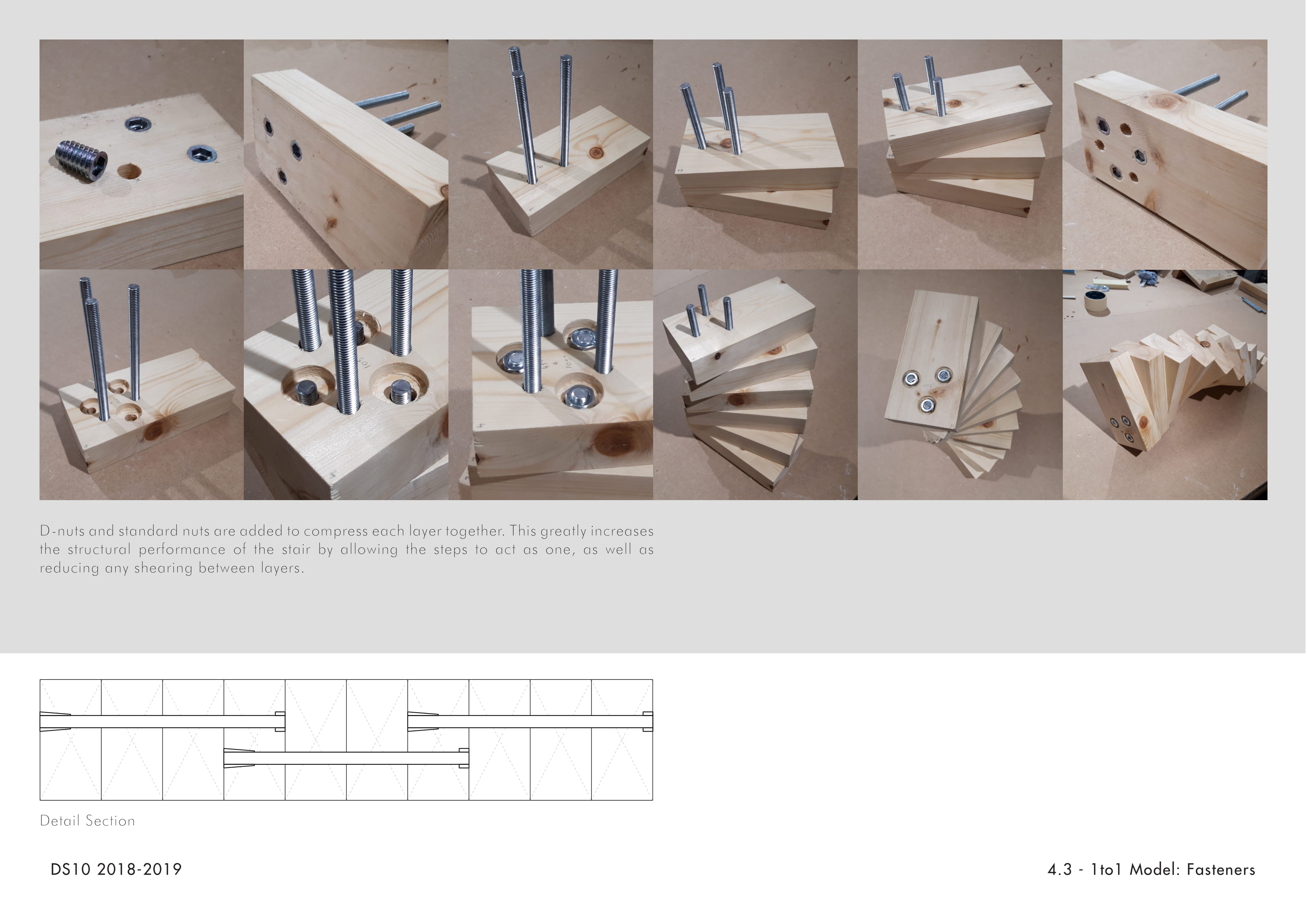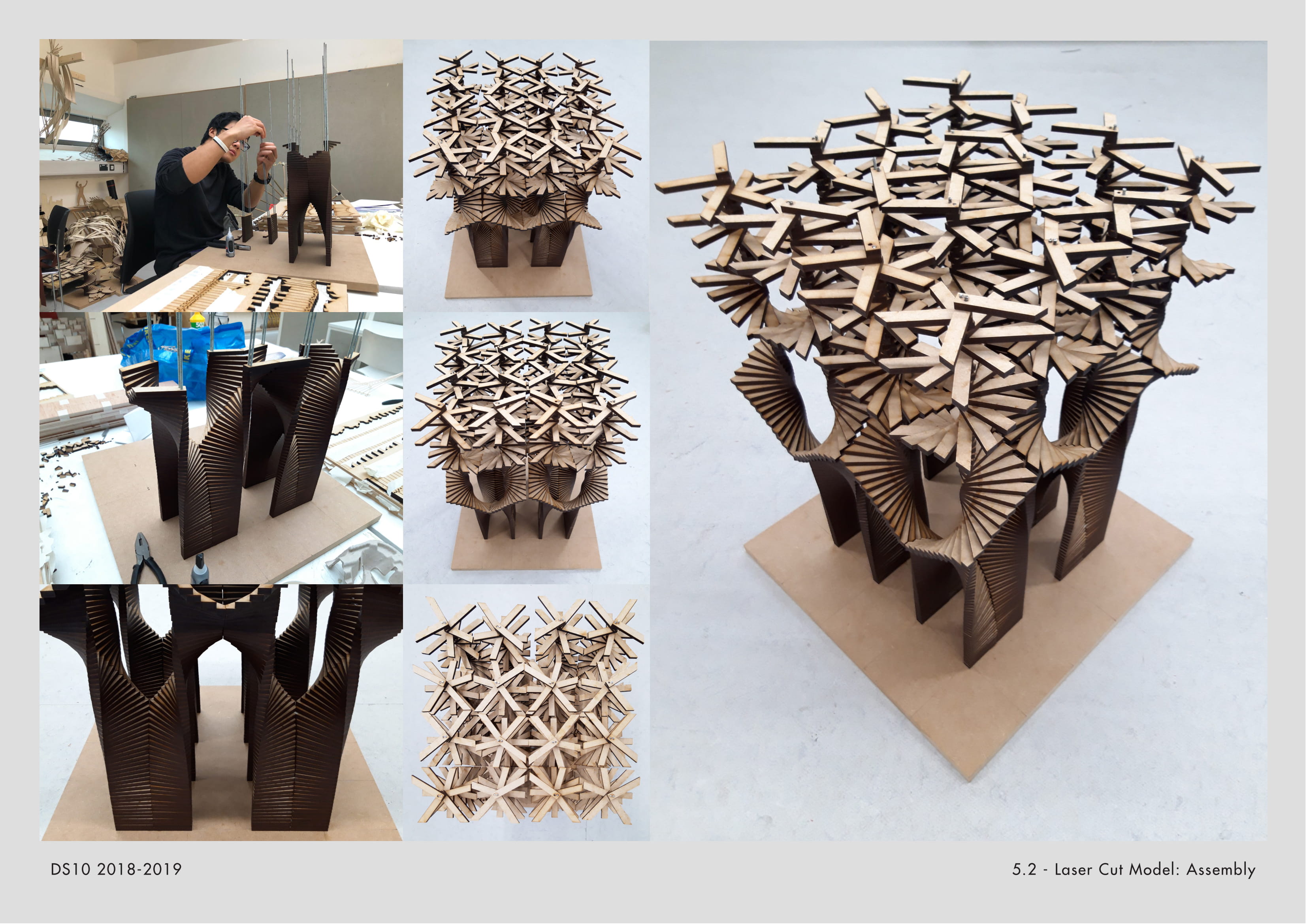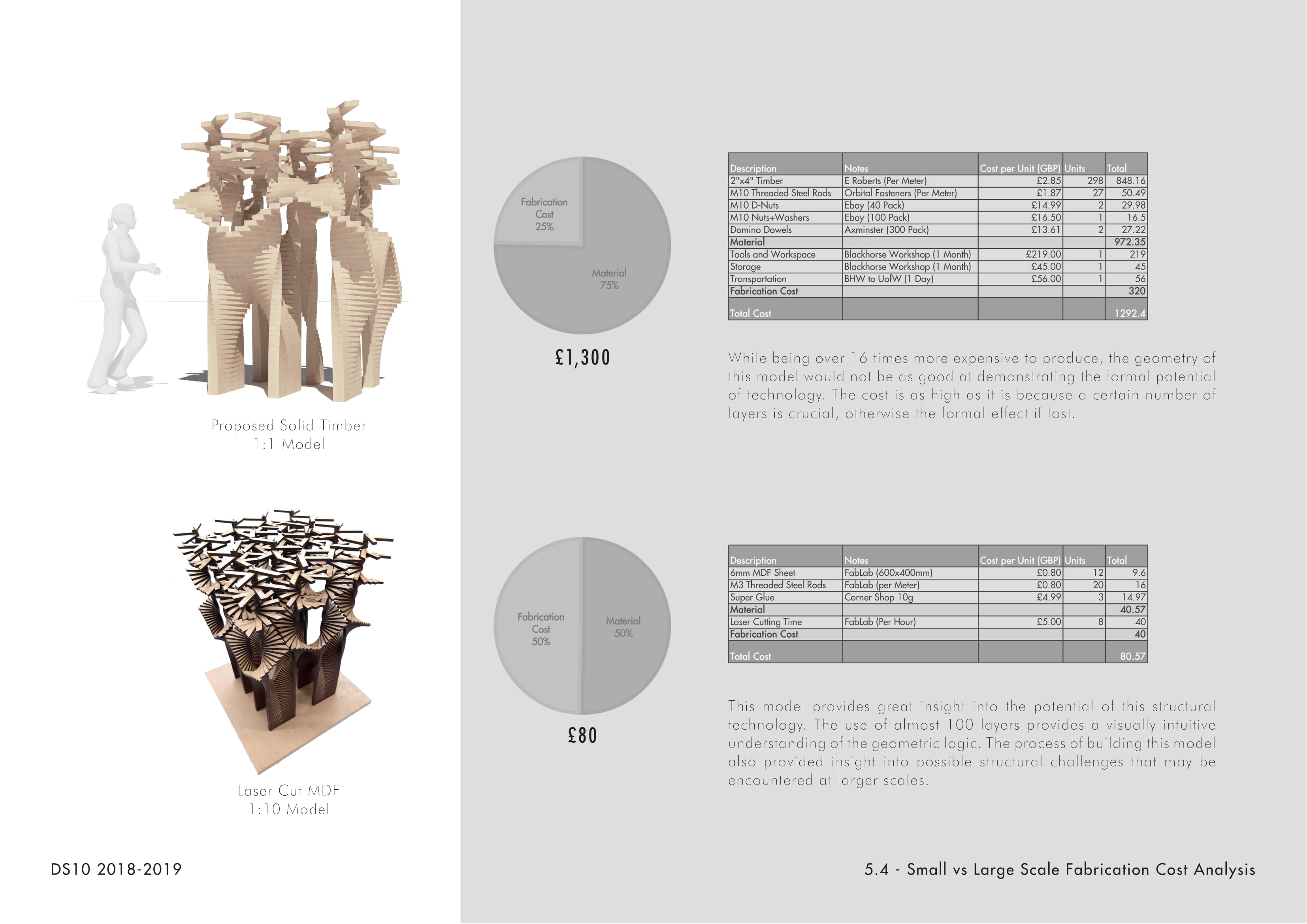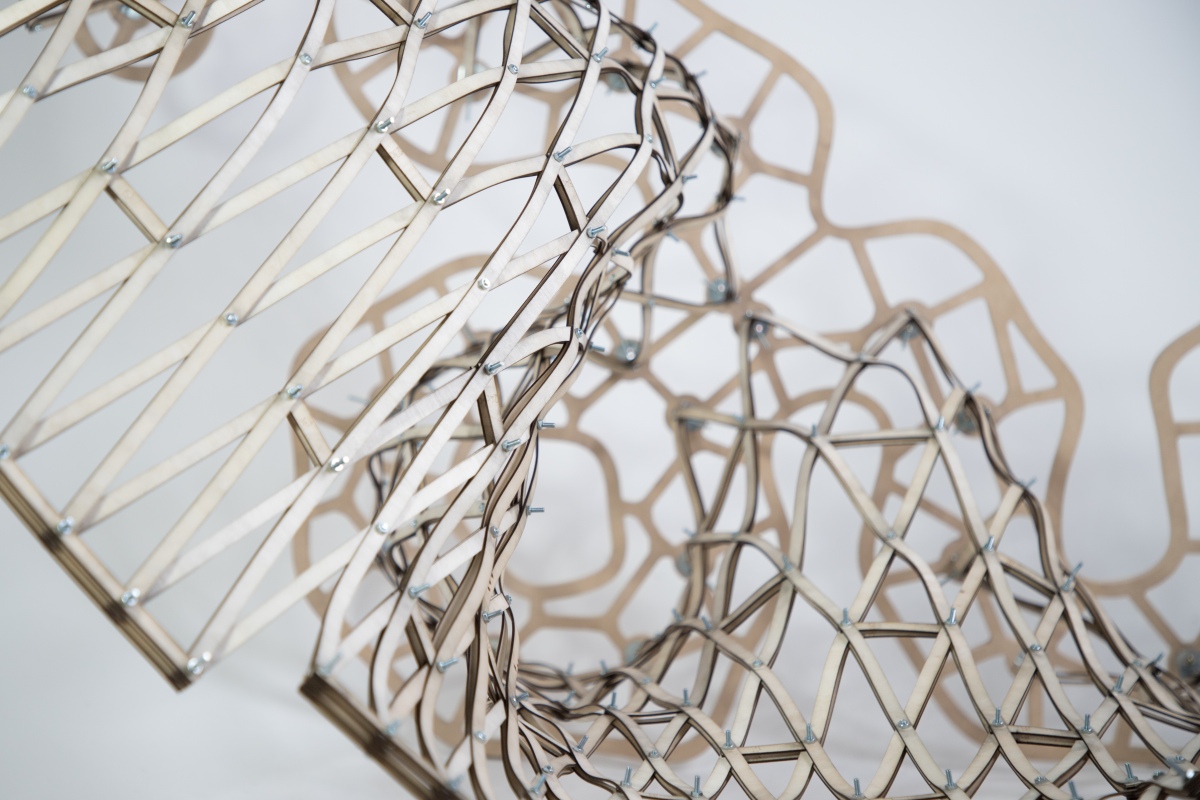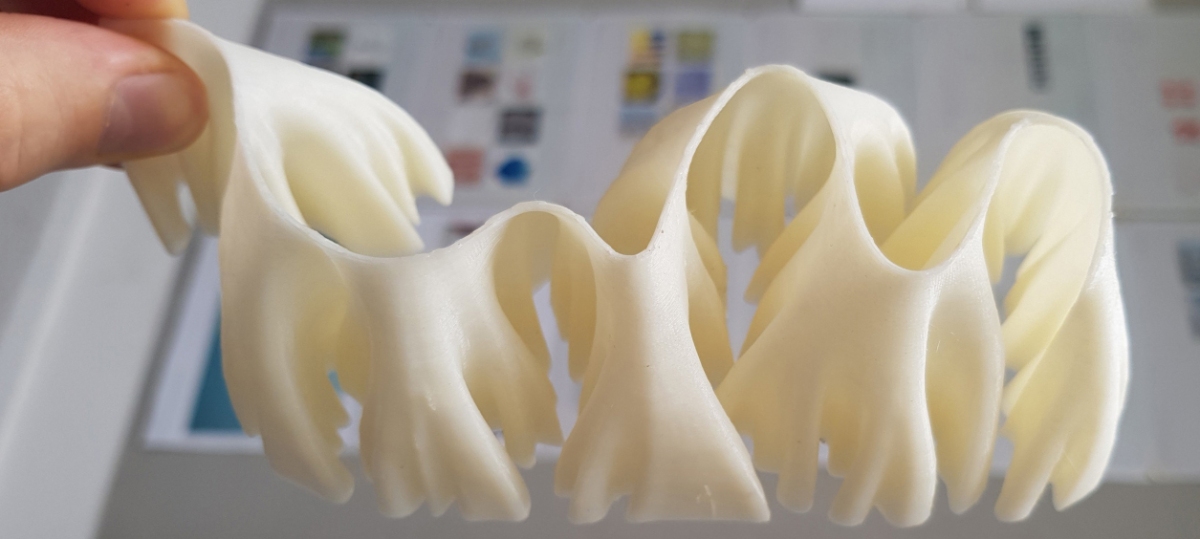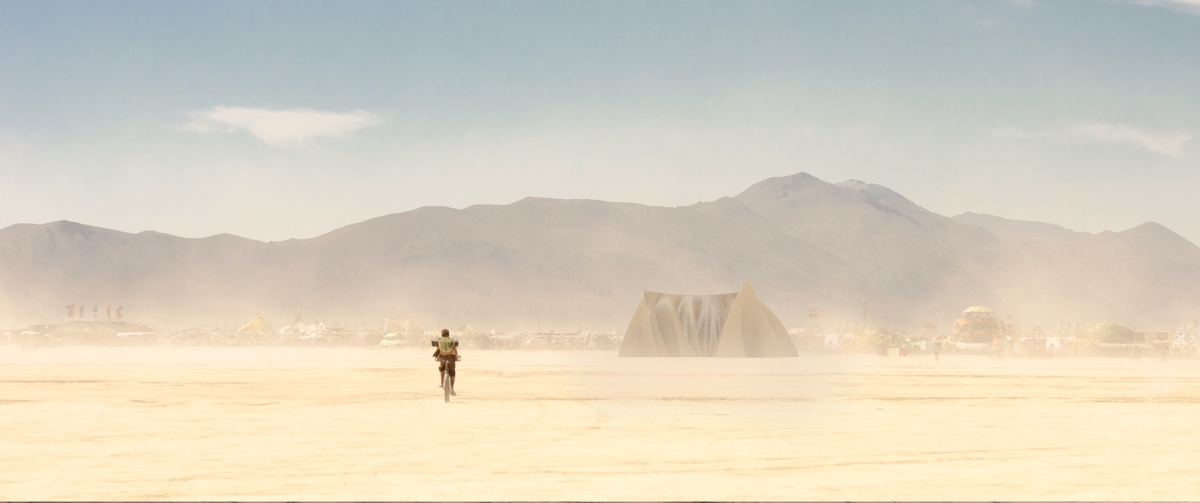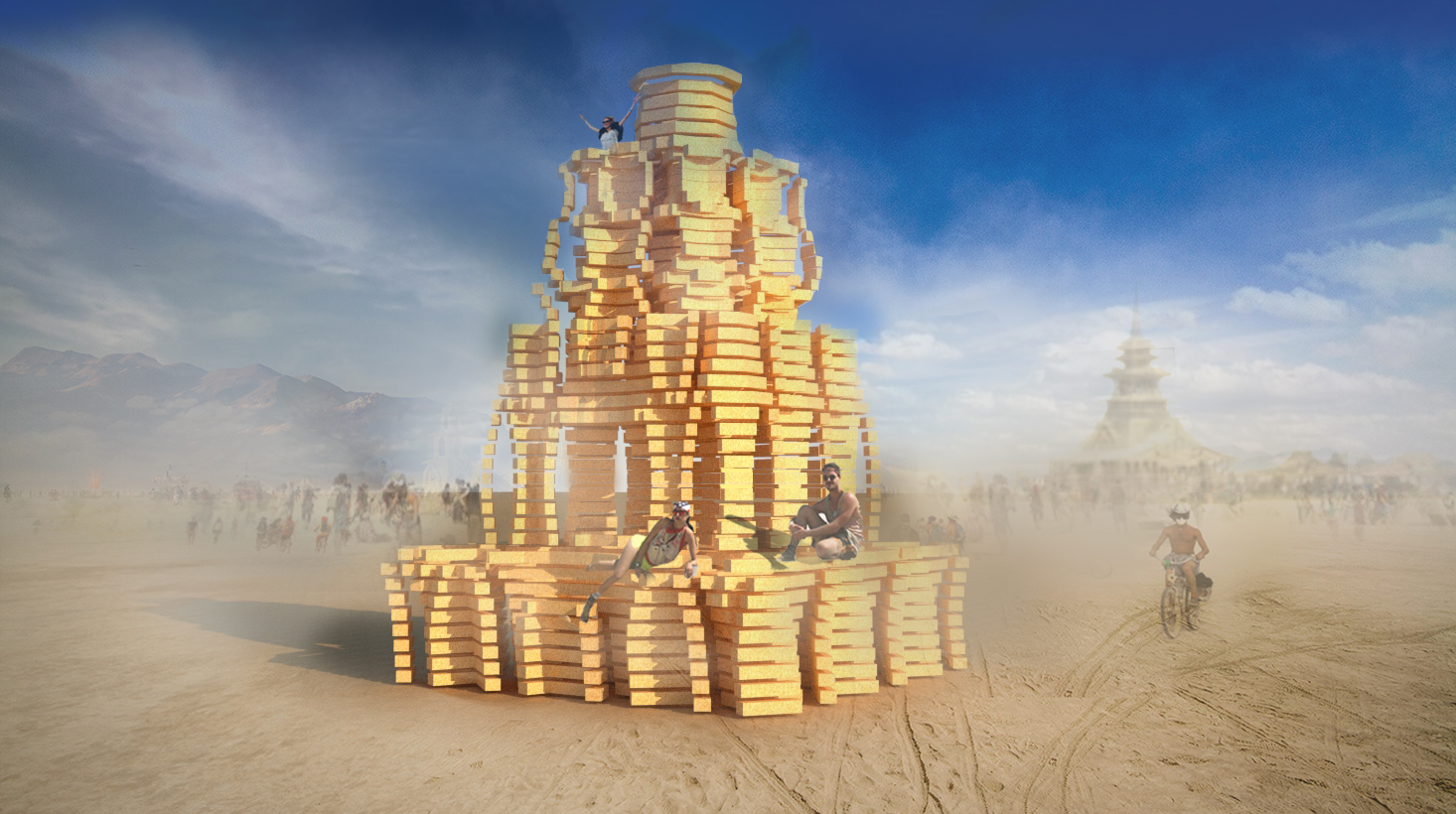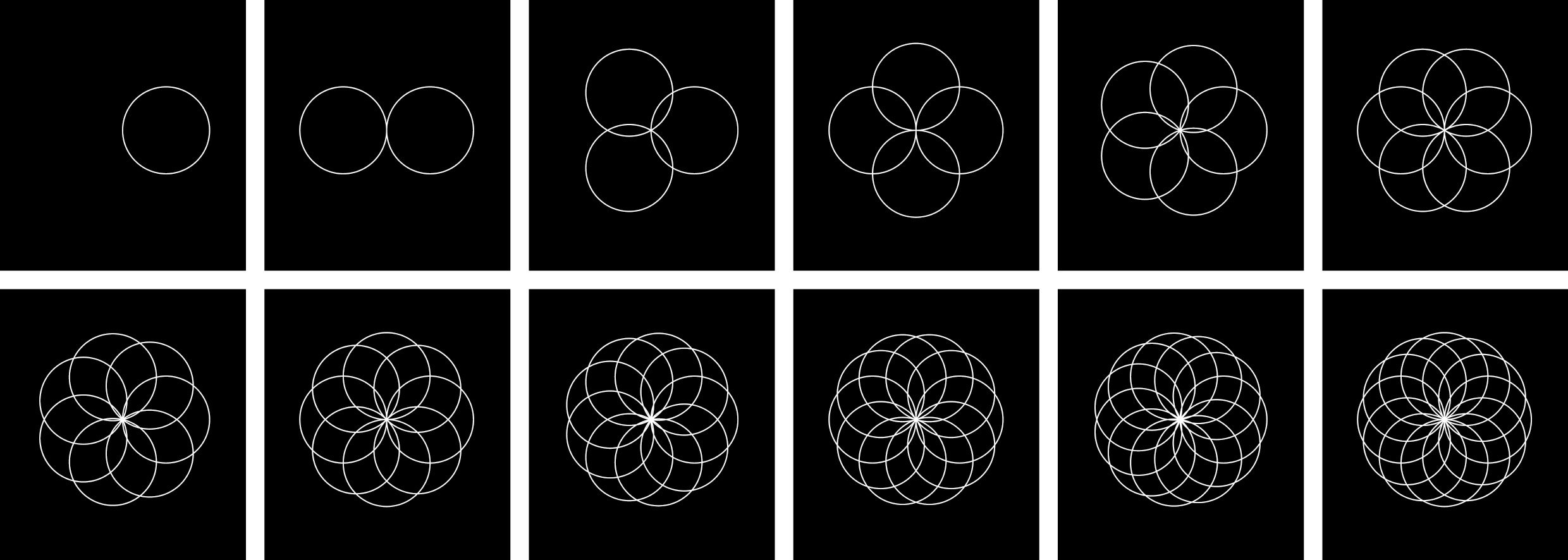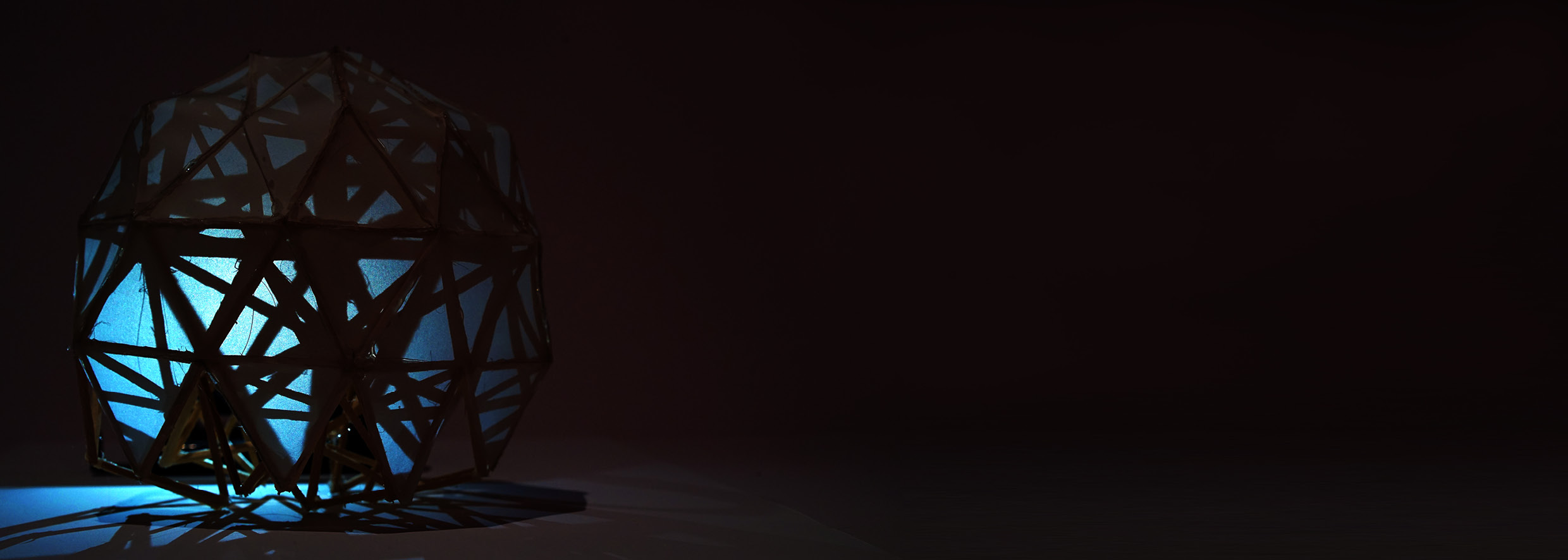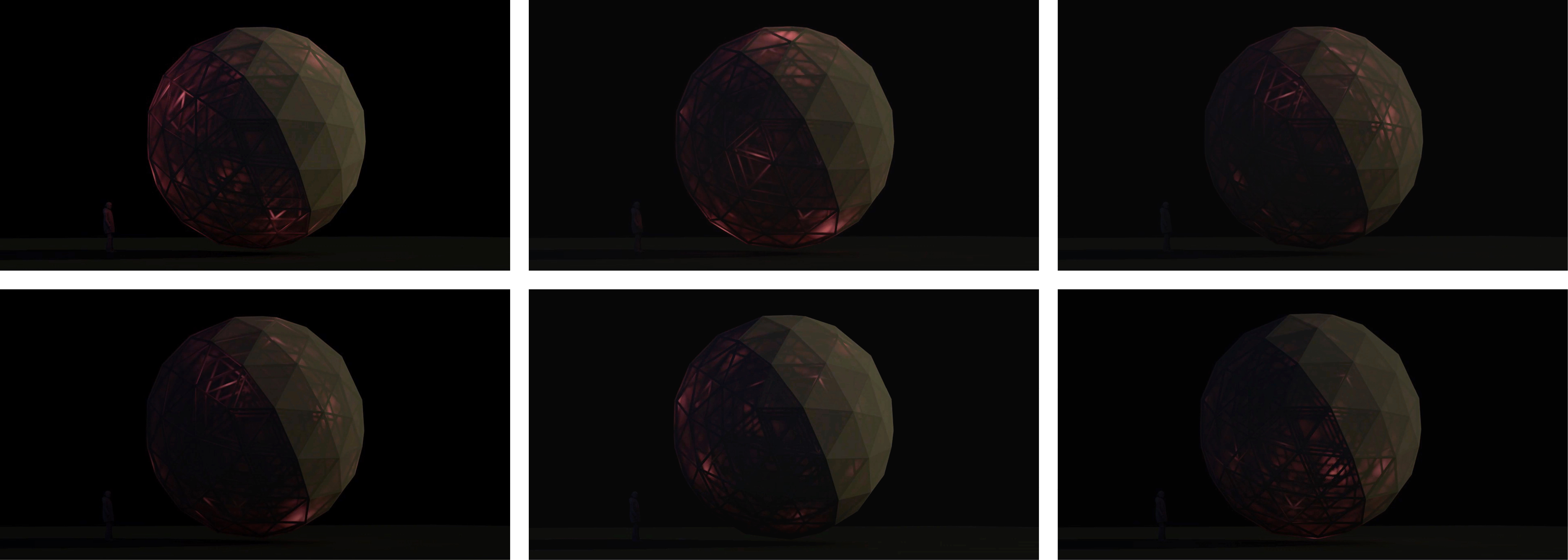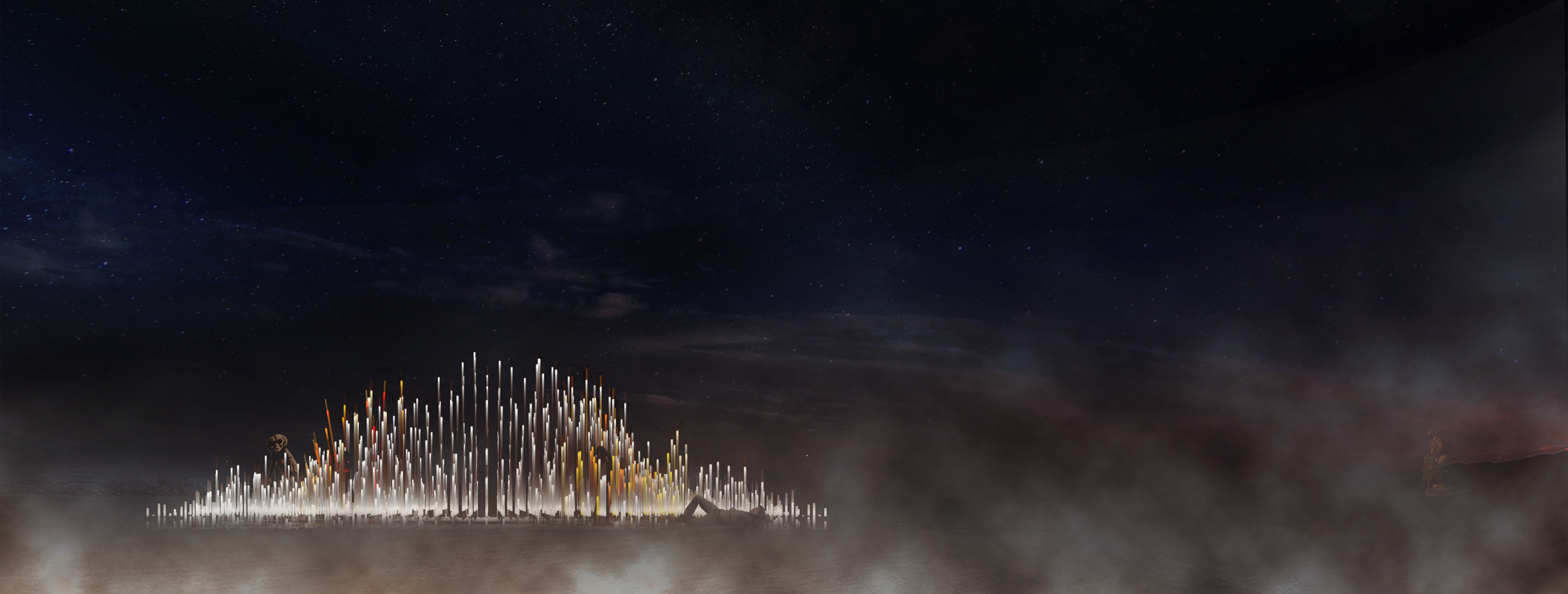Category: Rhino
The Nature of Gridshell Form Finding
Grids, shells, and how they, in conjunction with the study of the natural world, can help us develop increasingly complex structural geometry.
Foreword
This post is the third installment of sort of trilogy, after Shapes, Fractals, Time & the Dimensions they Belong to, and Developing Space-Filling Fractals. While it’s not important to have read either of those posts to follow this one, I do think it adds a certain level of depth and continuity.
Regarding my previous entries, it can be difficult to see how any of this has to do with architecture. In fact I know a few people who think studying fractals is pointless.
Admittedly I often struggle to explain to people what fractals are, let alone how they can influence the way buildings look. However, I believe that this post really sheds light on how these kinds of studies may directly influence and enhance our understanding (and perhaps even the future) of our built environment.
On a separate note, I heard that a member of the architectural academia said “forget biomimicry, it doesn’t work.”
Firstly, I’m pretty sure Frei Otto would be rolling over in his grave.
Secondly, if someone thinks that biomimicry is useless, it’s because they don’t really understand what biomimicry is. And I think the same can be said regarding the study of fractals. They are closely related fields of study, and I wholeheartedly believe they are fertile grounds for architectural marvels to come.
7.0 Introduction to Shells
As far as classification goes, shells generally fall under the category of two-dimensional shapes. They are defined by a curved surface, where the material is thin in the direction perpendicular to the surface. However, assigning a dimension to certain shells can be tricky, since it kinda depends on how zoomed in you are.
A strainer is a good example of this – a two-dimensional gridshell. But if you zoom in, it is comprised of a series of woven, one-dimensional wires. And if you zoom in even further, you see that each wire is of course comprised of a certain volume of metal.
This is a property shared with many fractals, where their dimension can appear different depending on the level of magnification. And while there’s an infinite variety of possible shells, they are (for the most part) categorizable.
7.1 – Single Curved Surfaces
Analytic geometry is created in relation to Cartesian planes, using mathematical equations and a coordinate systems. Synthetic geometry is essentially free-form geometry (that isn’t defined by coordinates or equations), with the use of a variety of curves called splines. The following shapes were created via Synthetic geometry, where we’re calling our splines ‘u’ and ‘v.’
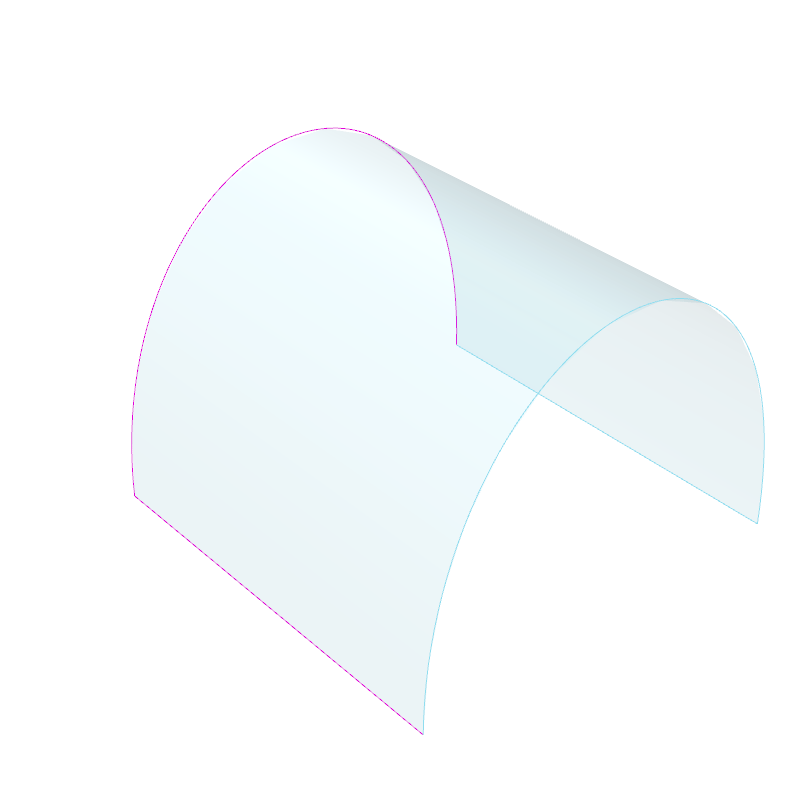
These curves highlight each dimension of the two-dimensional surface. In this case only one of the two ‘curves’ is actually curved, making this shape developable. This means that if, for example, it was made of paper, you could flatten it completely.
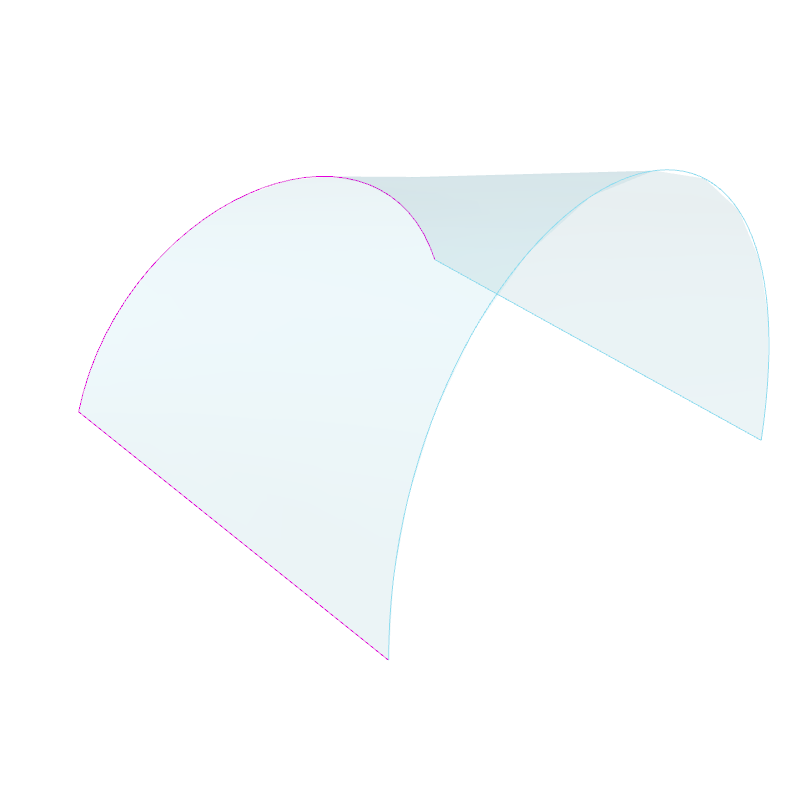
Uniclastic: Conoid (Conical paraboloid)
In this case, one of them grows in length, but the other still remains straight. Since one of the dimensions remains straight, it’s still a single curved surface – capable of being flattened without changing the area. Singly curved surfaced may also be referred to as uniclastic or monoclastic.
7.2 – Double Curved Surfaces
These can be classified as synclastic or anticlastic, and are non-developable surfaces. If made of paper, you could not flatten them without tearing, folding or crumpling them.
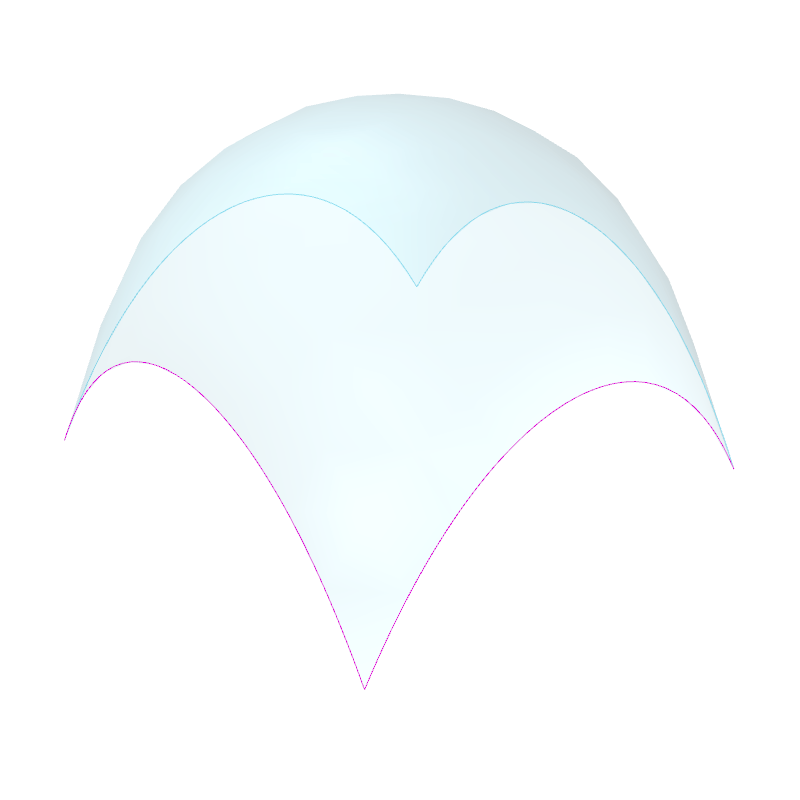
In this case, both curves happen to be identical, but what’s important is that both dimensions are curving in the same direction. In this orientation, the dome is also under compression everywhere.
The surface of the earth is double curved, synclastic – non-developable. “The surface of a sphere cannot be represented on a plane without distortion,” a topic explored by Michael Stevens: https://www.youtube.com/watch?v=2lR7s1Y6Zig
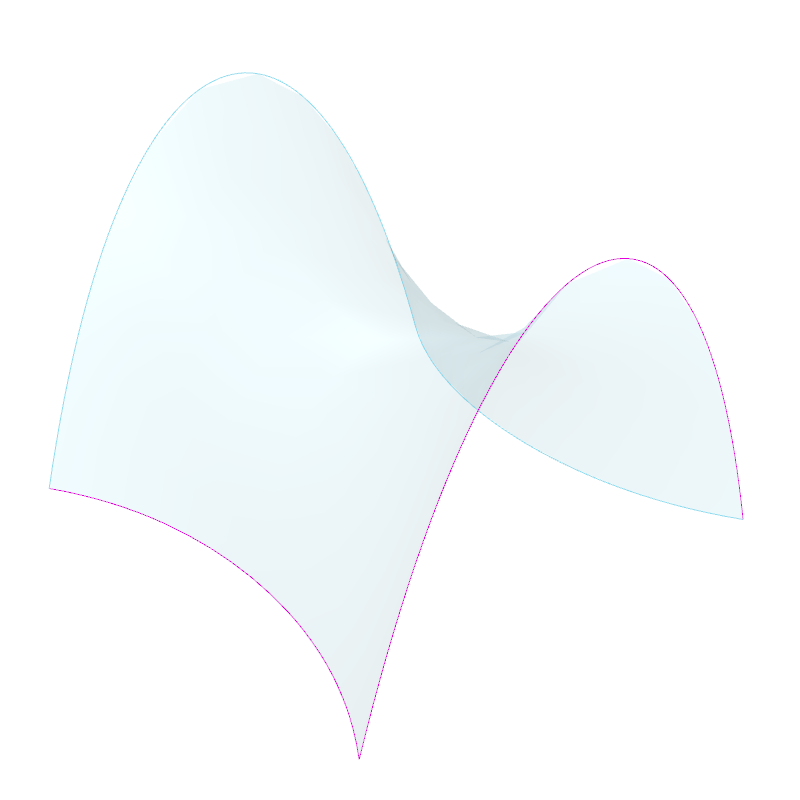
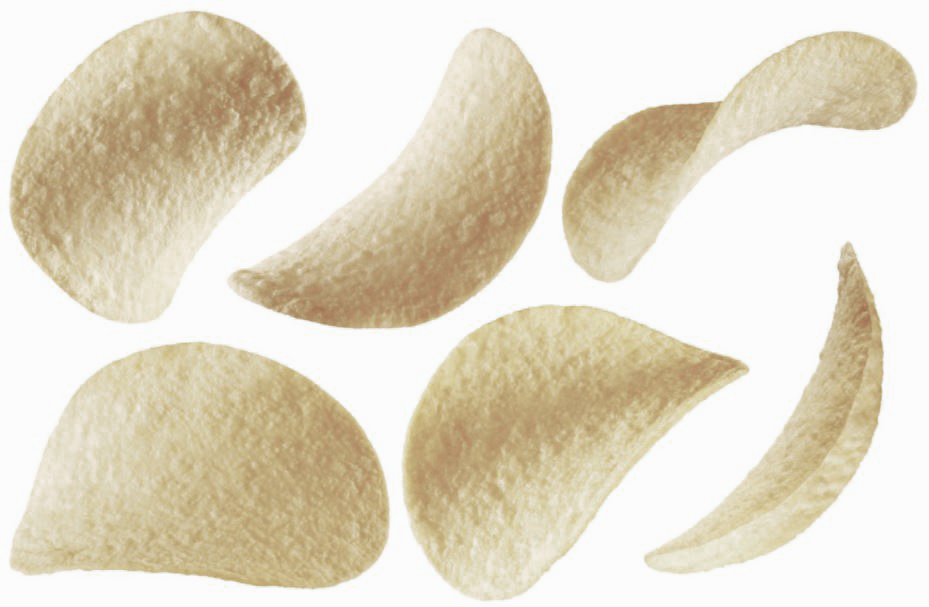
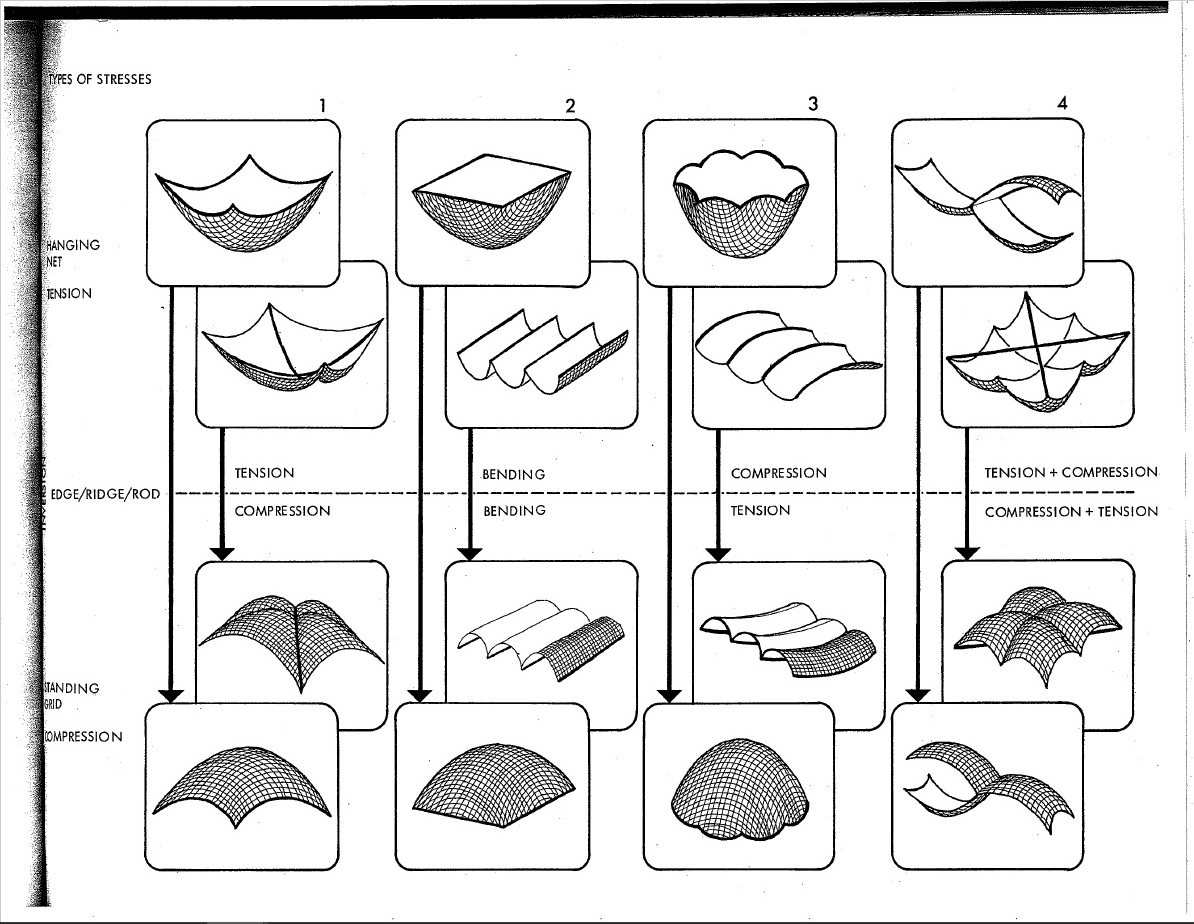
7.3 – Translation vs Revolution
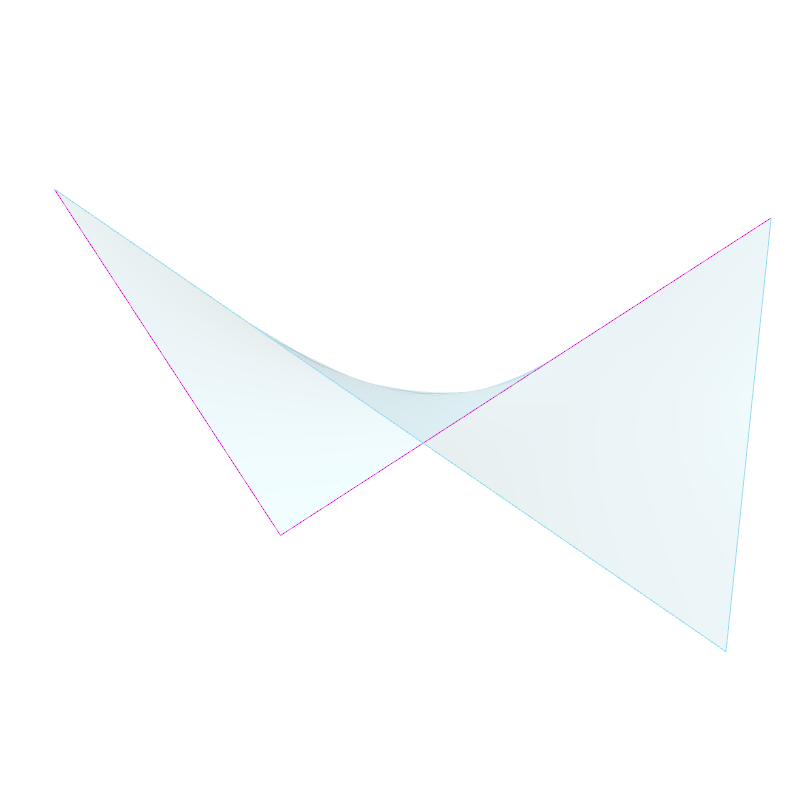
This shape was achieved by sweeping a straight line over a straight path at one end, and another straight path at the other. This will work as long as both rails are not parallel. Although I find this shape perplexing; it’s double curvature that you can create with straight lines, yet non-developable, and I can’t explain it..
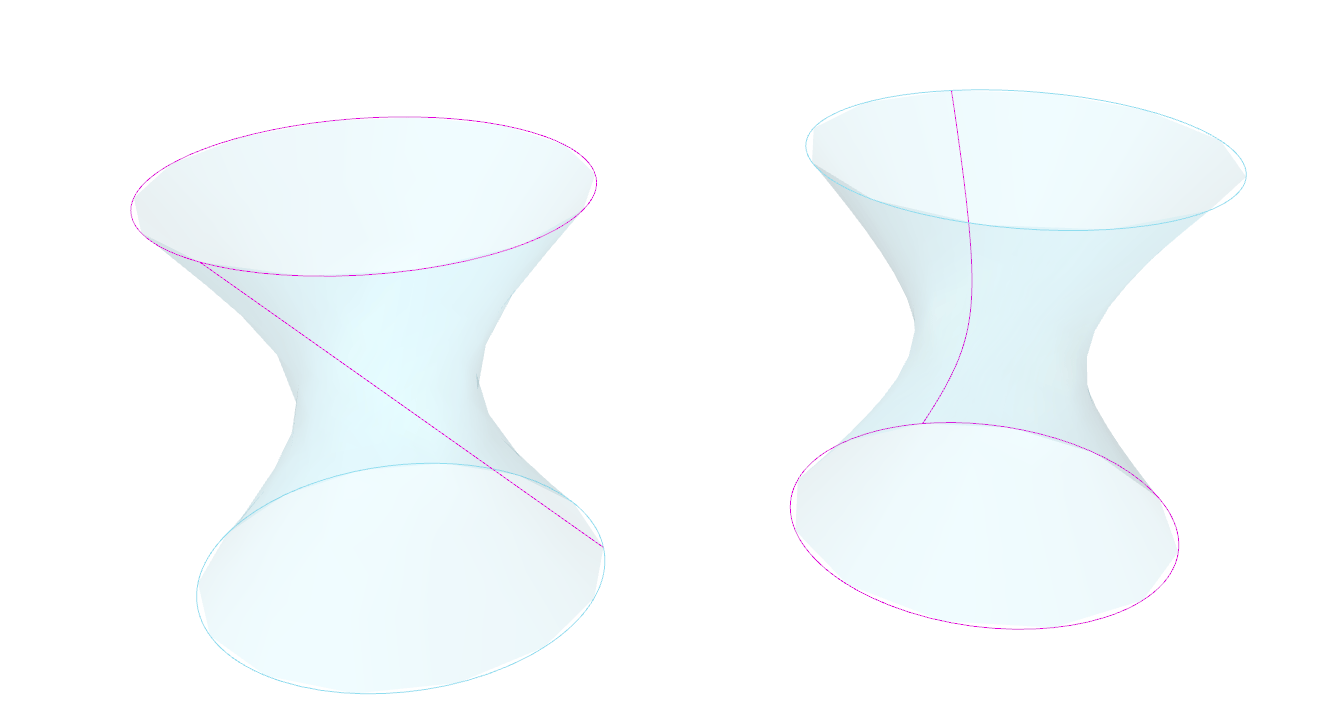
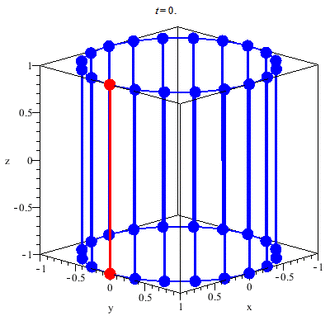
The hyperboloid has been a popular design choice for (especially nuclear cooling) towers. It has excellent tensile and compressive properties, and can be built with straight members. This makes it relatively cheap and easy to fabricate relative to it’s size and performance.
8.0 Geodesic Curves
These are singly curved curves, although that does sound confusing. A simple way to understand what geodesic curves are, is to give them a width. As previously explored, we know that curves can inhabit, and fill, two-dimensional space. However, you can’t really observe the twists and turns of a shape that has no thickness.
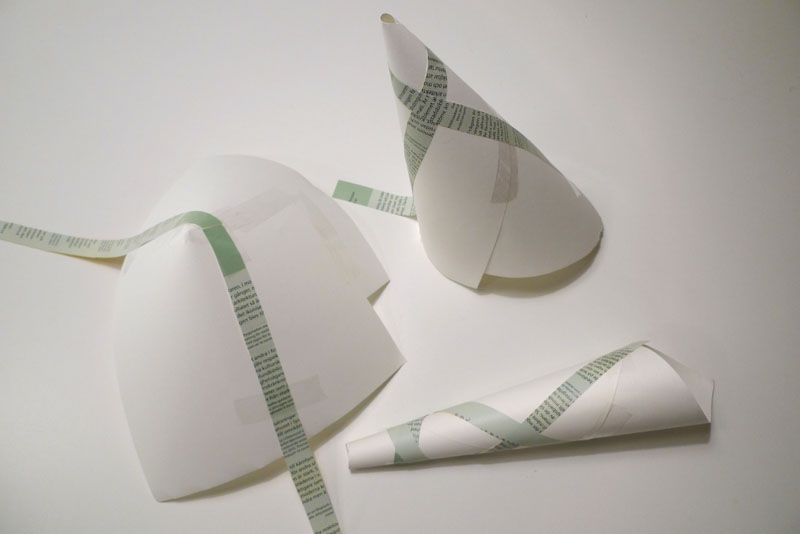
A ribbon is essentially a straight line with thickness, and when used to follow the curvature of a surface (as seen above), the result is a plank line. The term ‘plank line’ can be defined as a line with an given width (like a plank of wood) that passes over a surface and does not curve in the tangential plane, and whose width is always tangential to the surface.
Since one-dimensional curves do have an orientation in digital modeling, geodesic curves can be described as the one-dimensional counterpart to plank lines, and can benefit from the same definition.
The University of Southern California published a paper exploring the topic further: http://papers.cumincad.org/data/works/att/f197.content.pdf
8.1 – Basic Grid Setup
For simplicity, here’s a basic grid set up on a flat plane:
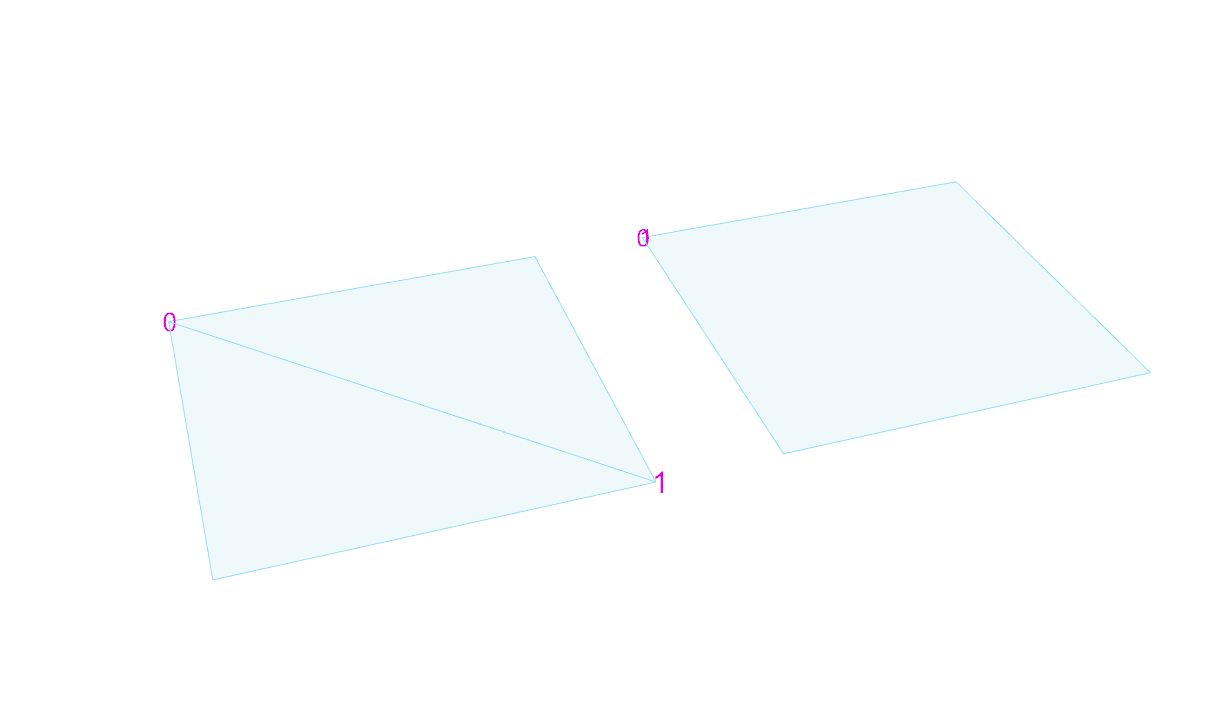
We start by defining two points anywhere along the edge of the surface. Then we find the geodesic curve that joins the pair. Of course it’s trivial in this case, since we’re dealing with a flat surface, but bear with me.
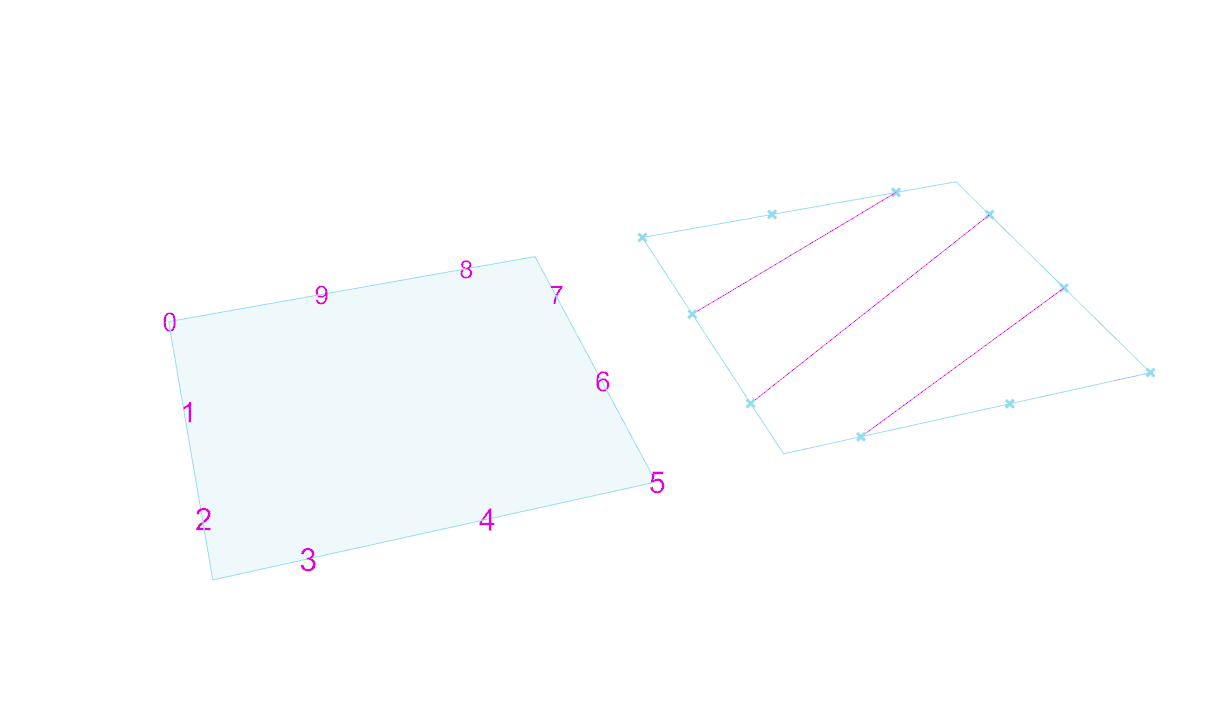
We can keep adding pairs of points along the edge. In this case they’re kept evenly spaced and uncrossing for the sake of a cleaner grid.
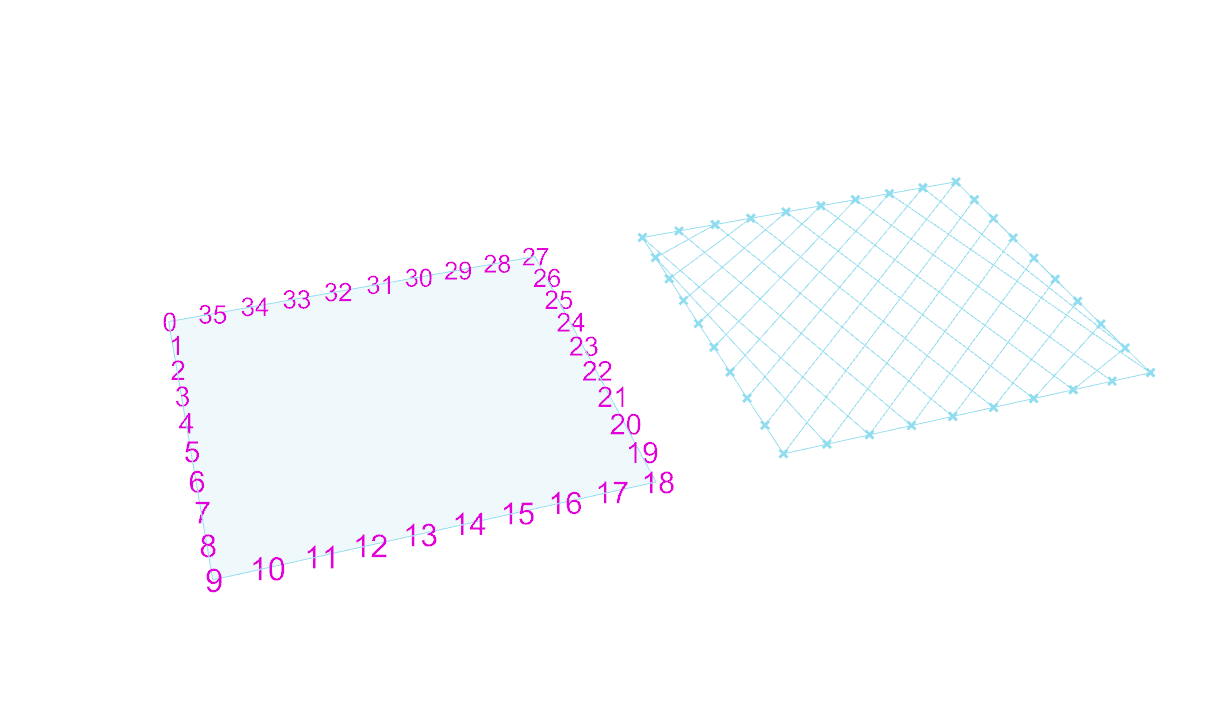
After that, it’s simply a matter of playing with density, as well as adding an additional set of antagonistic curves. For practicality, each set share the same set of base points.
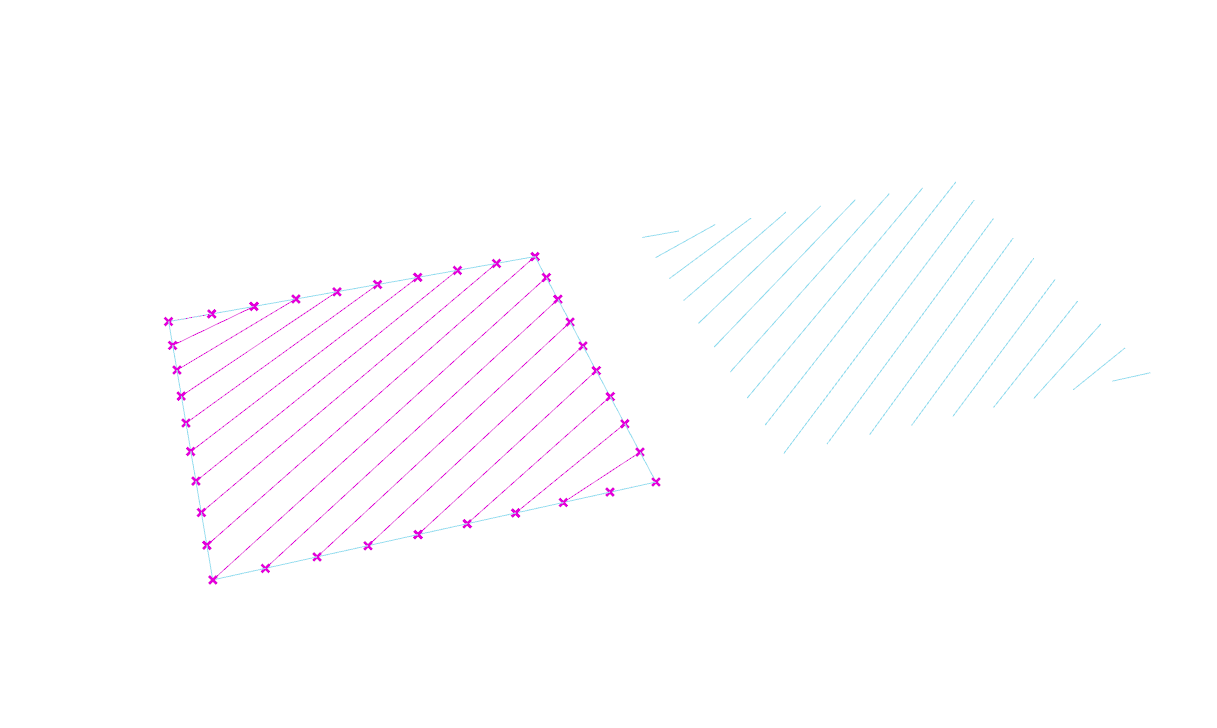
He’s an example of a grid where each set has their own set of anchors. While this does show the flexibility of a grid, I think it’s far more advantageous for them to share the same base points.
8.2 – Basic Gridshells
The same principle is then applied to a series of surfaces with varied types of curvature.
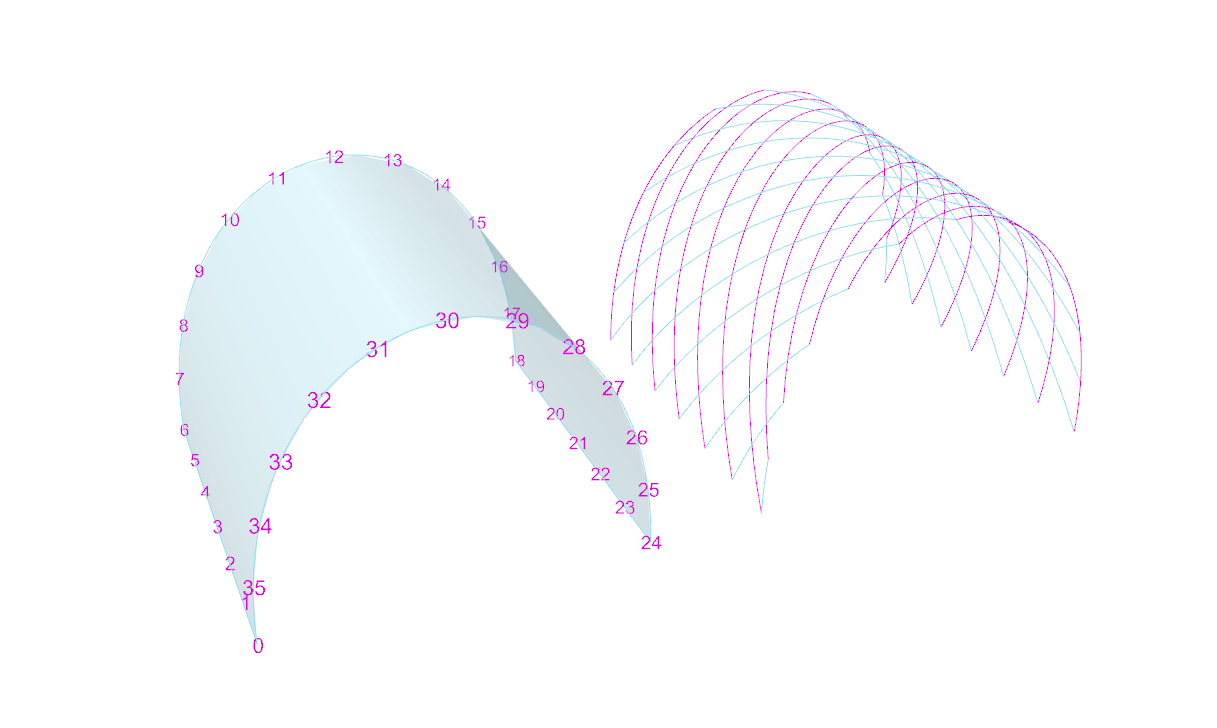
First comes the shell (a barrel vault in this case), then comes the grid. The symmetrical nature of this surface translates to a pretty regular (and also symmetrical) gridshell. The use of geodesic curves means that these gridshells can be fabricated using completely straight material, that only necessitate single curvature.
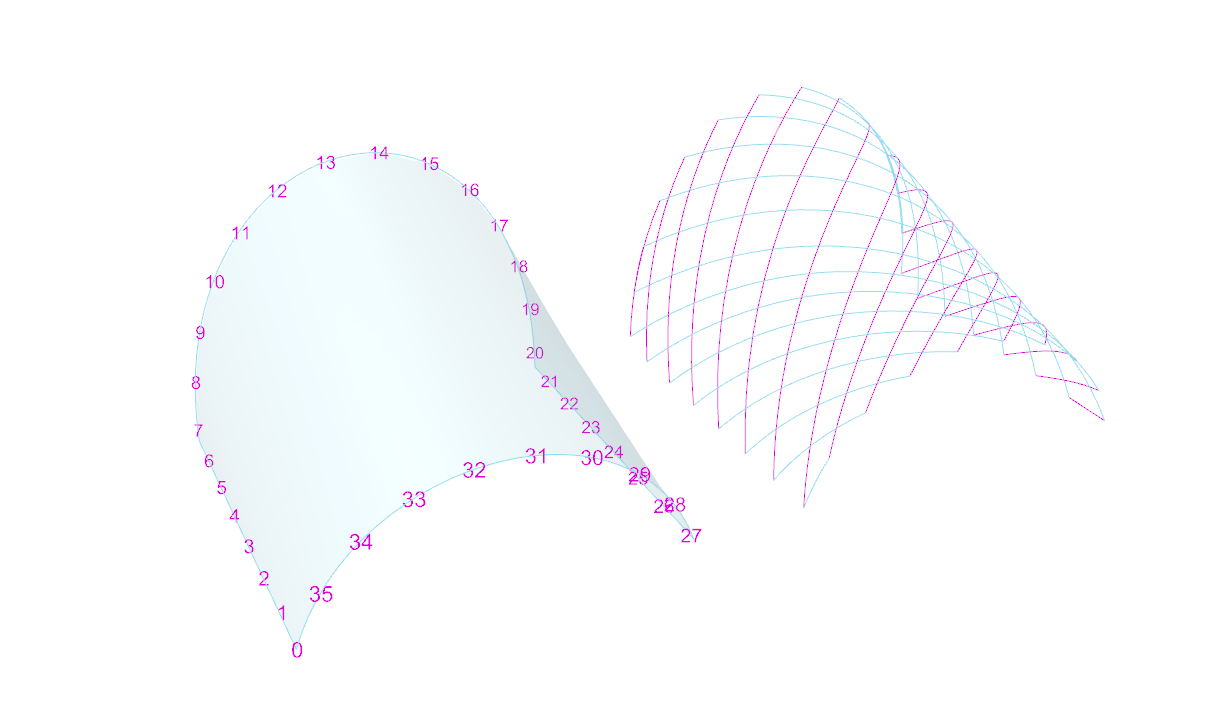
The same grid used on a conical surface starts to reveal gradual shifts in the geometry’s spacing. The curves always search for the path of least resistance in terms of bending.
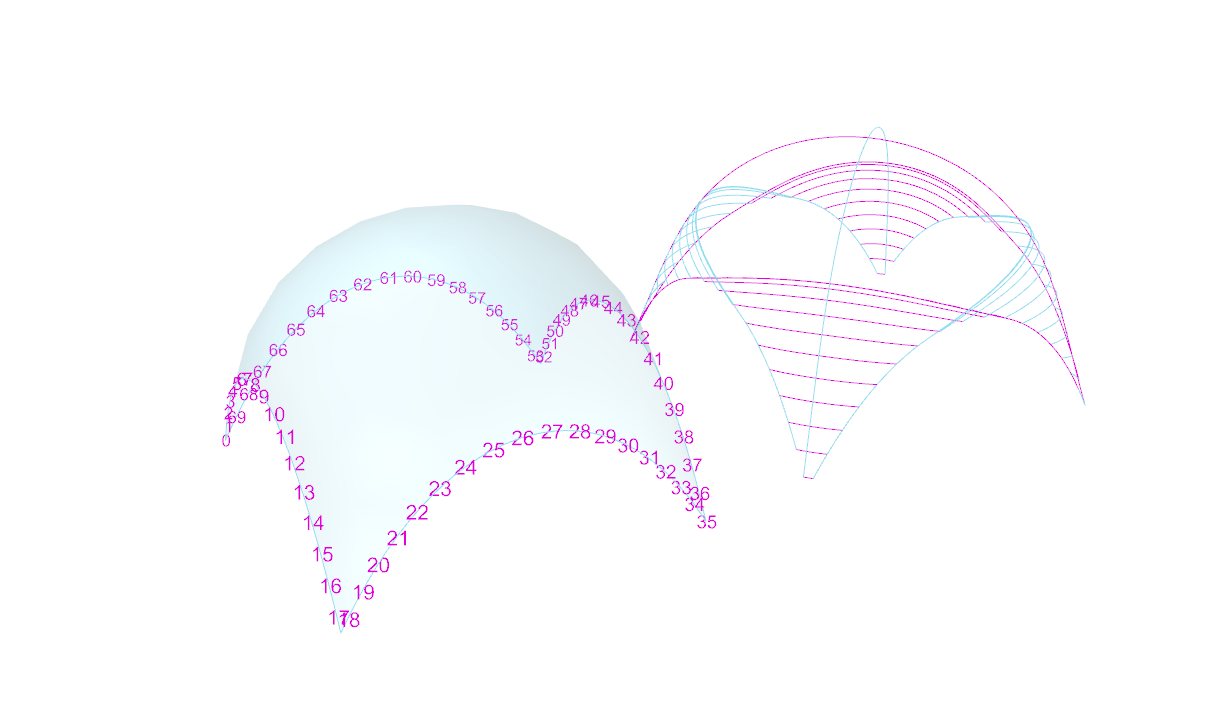
This case illustrates the nature of geodesic curves quite well. The dome was free-formed with a relatively high degree of curvature. A small change in the location of each anchor point translates to a large change in curvature between them. Each curve looks for the shortest path between each pair (without leaving the surface), but only has access to single curvature.
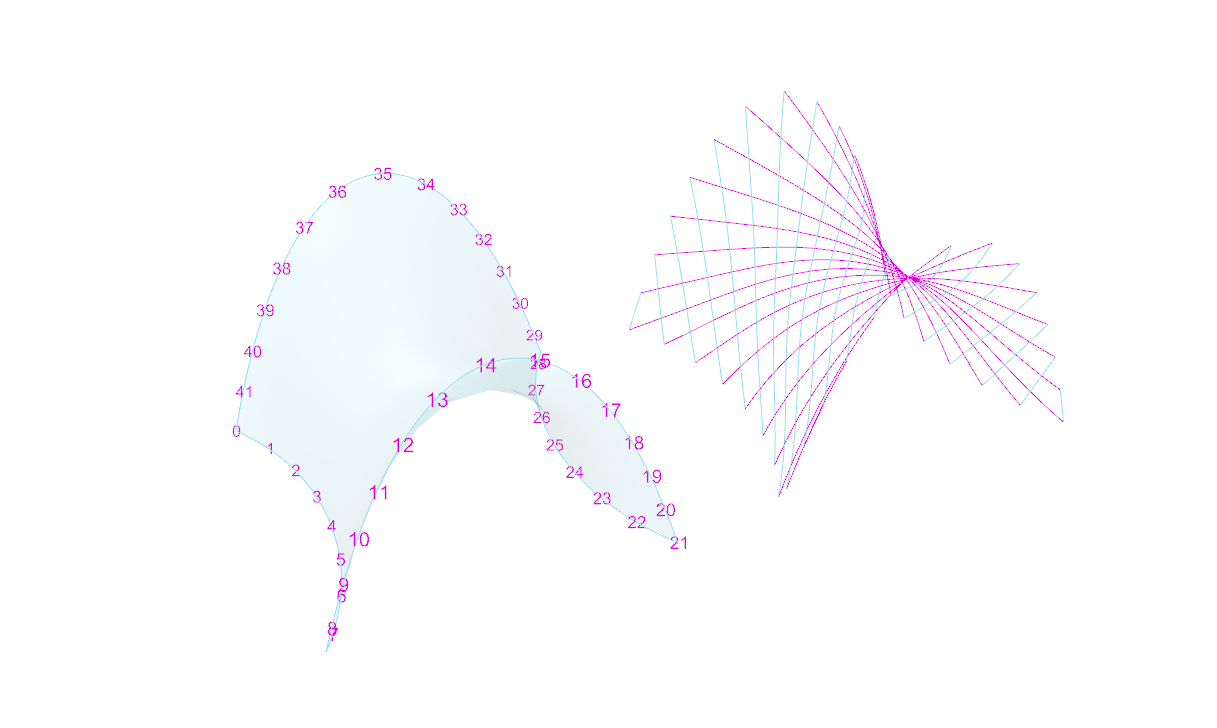
Structurally speaking, things get much more interesting with anticlastic curvature. As previously stated, each member will behave differently based on their relative curvature and orientation in relation to the surface. Depending on their location on a gridshell, plank lines can act partly in compression and partly in tension.
On another note:
While geodesic curves make it far more practical to fabricate shells, they are not a strict requirement. Using non-geodesic curves just means more time, money, and effort must go into the fabrication of each component. Furthermore, there’s no reason why you can’t use alternate grid patterns. In fact, you could use any pattern under the sun – any motif your heart desires (even tessellated puppies.)
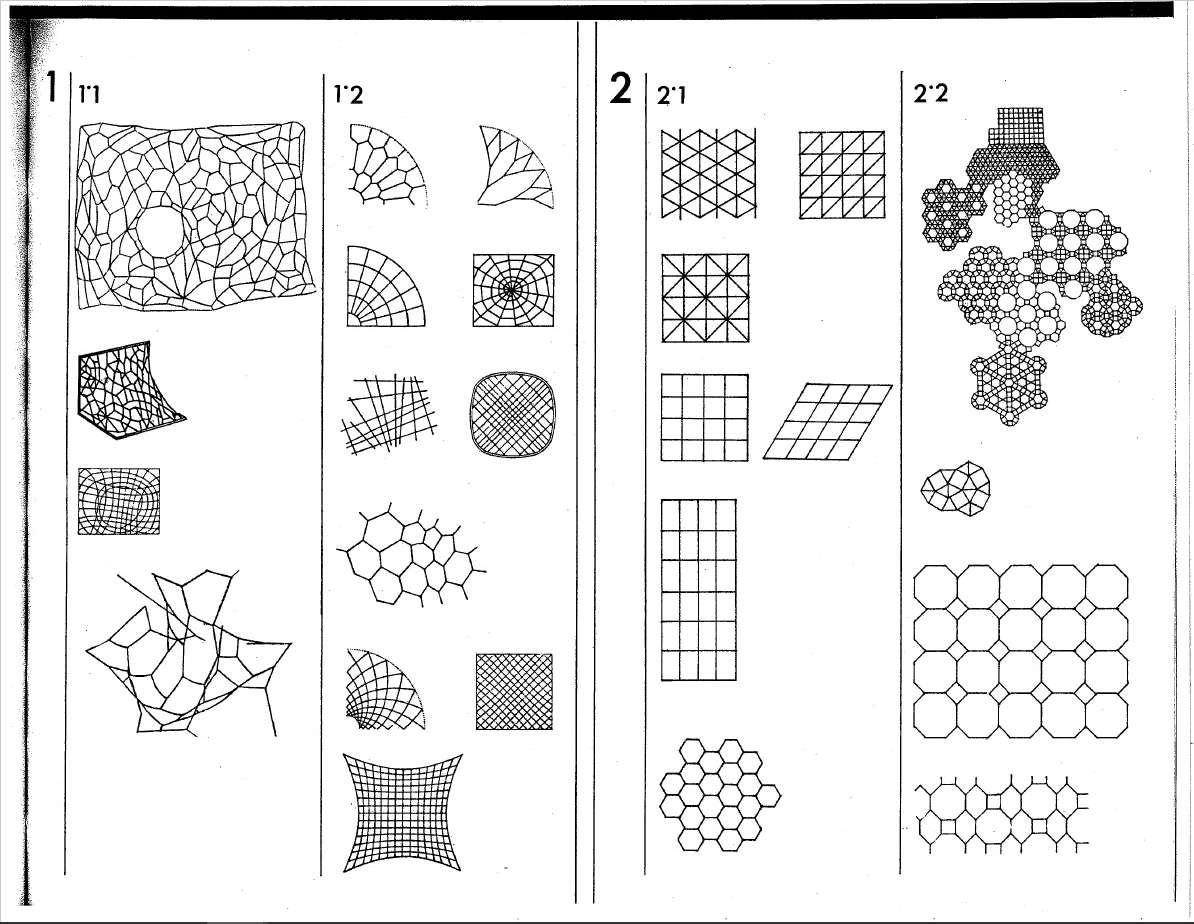
Here are just a few of the endless possible pattern. They all have their advantages and disadvantages in terms of fabrication, as well as structural potential.
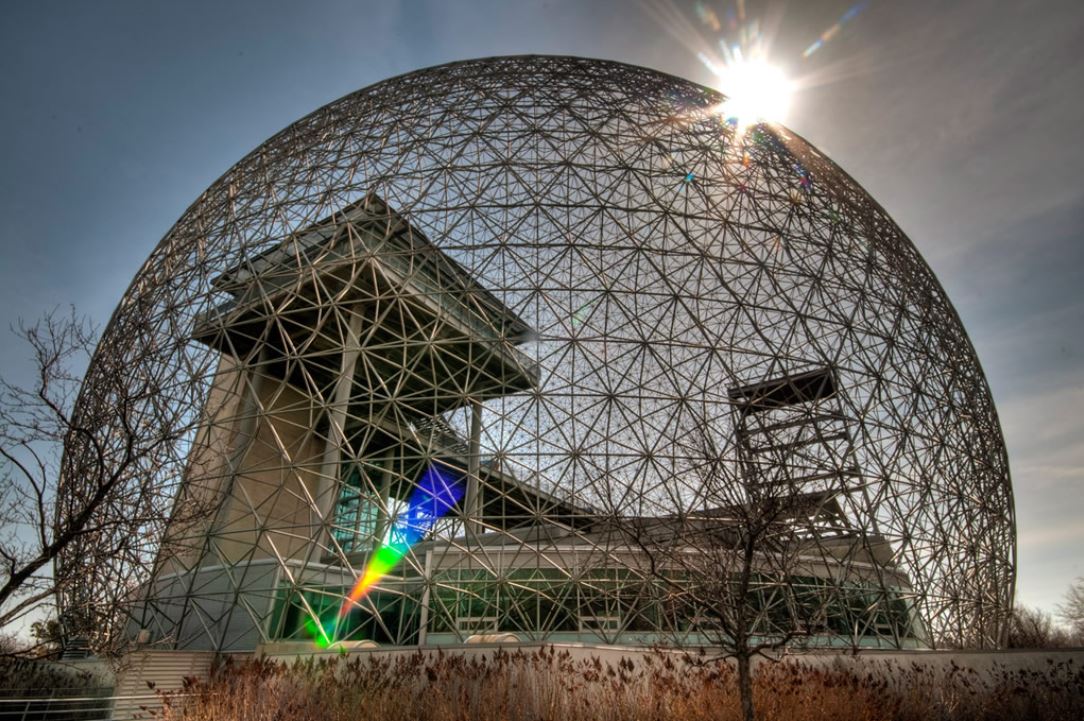
Gridshells with large amounts of triangulation, such as Buckminster Fuller’s geodesic spheres, typically perform incredibly well structurally. These structure are also highly efficient to manufacture, as their geometry is extremely repetitive.
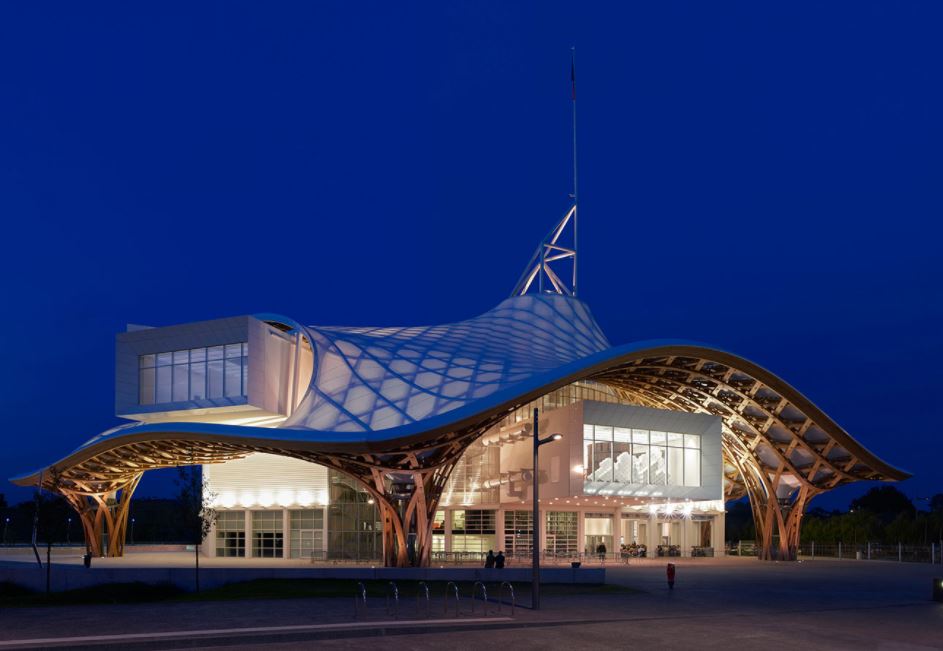
Gridshells with highly irregular geometry are far more challenging to fabricate. In this case, each and every piece had to be custom made to shape; I imagine it must have costed a lot of money, and been a logistical nightmare. Although it is an exceptionally stunning piece of architecture (and a magnificent feat of engineering.)
8.3 – Gridshell Construction
In our case, building these shells is simply a matter of converting the geodesic curves into planks lines.
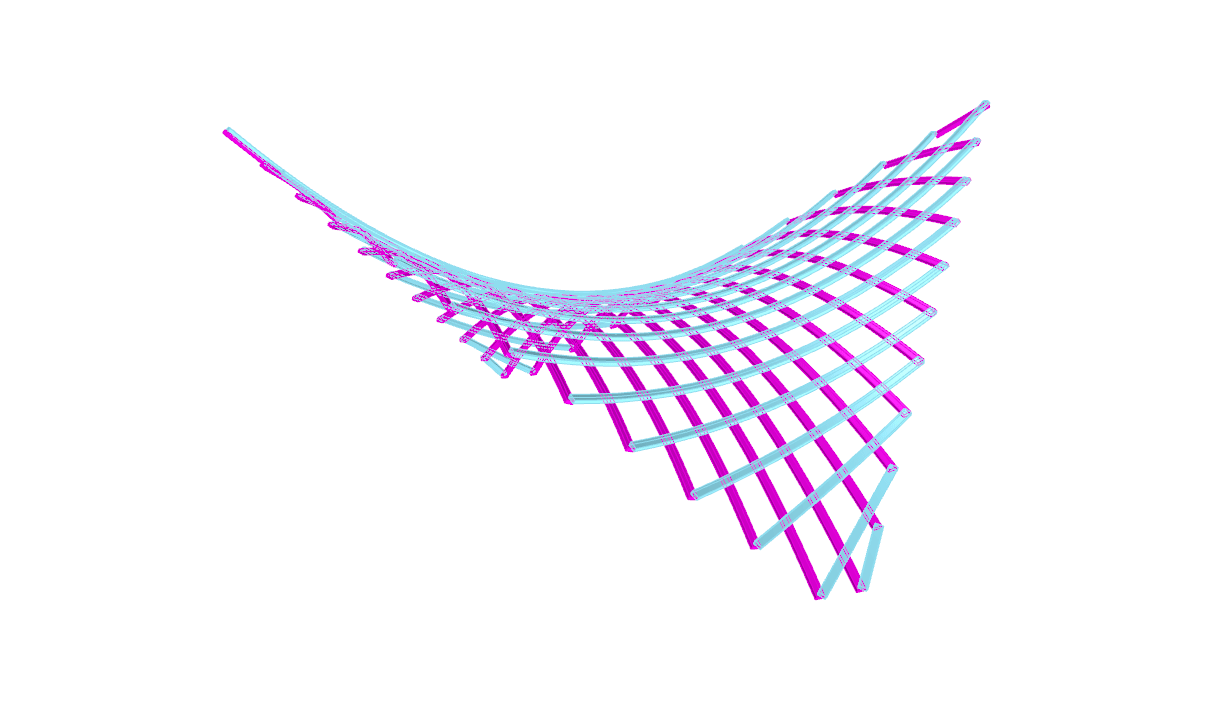
The whole point of using them in the first place is so that we can make them out of straight material that don’t necessitate double curvature. This example is rotating so the shape is easier to understand. It’s grid is also rotating to demonstrate the ease at which you can play with the geometry.
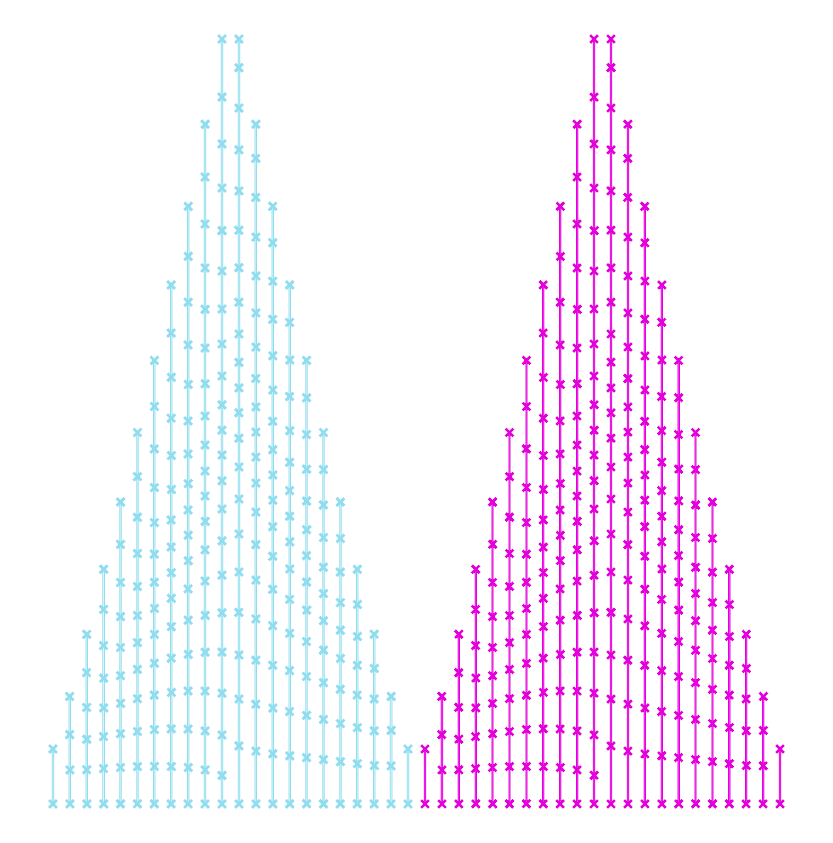
This is what you get by taking those plank lines and laying them flat. In this case both sets are the same because the shell happens to the identicall when flipped. Being able to use straight material means far less labour and waste, which translates to faster, and or cheaper, fabrication.
An especially crucial aspect of gridshells is the bracing. Without support in the form of tension ties, cable ties, ring beams, anchors etc., many of these shells can lay flat. This in and of itself is pretty interesting and does lends itself to unique construction challenges and opportunities. This isn’t always the case though, since sometimes it’s the geometry of the joints holding the shape together (like the geodesic spheres.) Sometimes the member are pre-bent (like Pompidou-Metz.) Although pre-bending the timber kinda strikes me as cheating thought.. As if it’s not a genuine, bona fide gridshell.
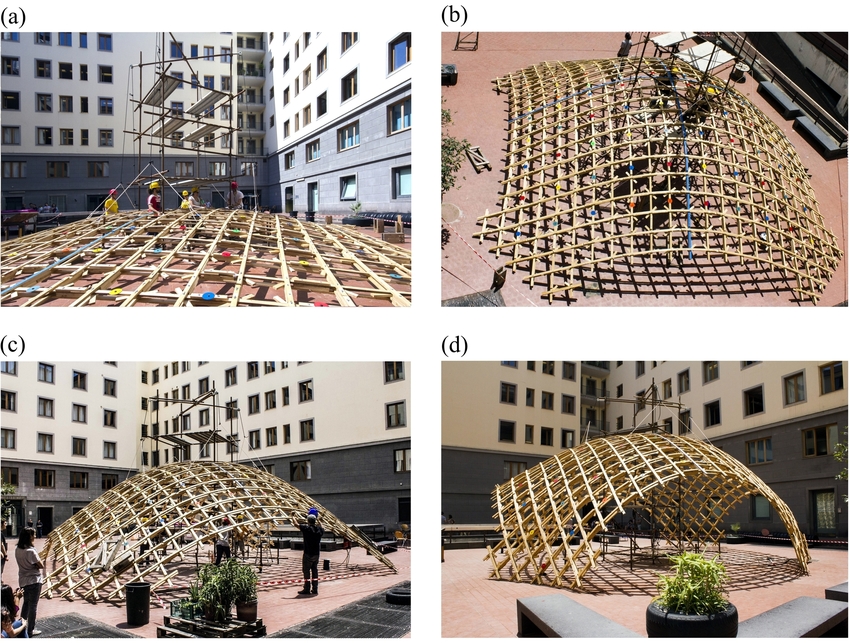
This is one of the original build method, where the gridshell is assembled flat, lifted into shape, then locked into place.
9.0 Form Finding
Having studied the basics makes exploring increasingly elaborate geometry more intuitive. In principal, most of the shells we’ve looked are known to perform well structurally, but there are strategies we can use to focus specifically on performance optimization.
9.0 – Minimal Surfaces
These are surfaces that are locally area-minimizing – surfaces that have the smallest possible area for a defined boundary. They necessarily have zero mean curvature, i.e. the sum of the principal curvatures at each point is zero. Soap bubbles are a great example of this phenomenon.
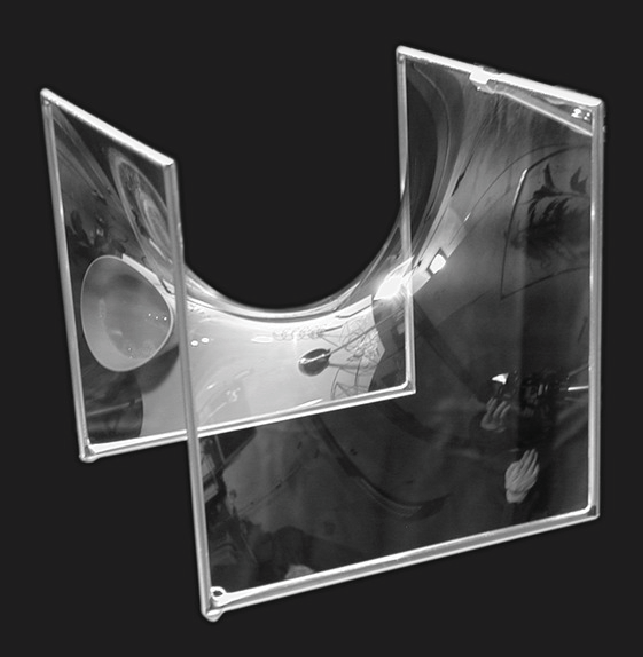
Hyperbolic Paraboloid Soap Bubble [Source: Serfio Musmeci’s “Froms With No Name” and “Anti-Polyhedrons”]Soap film inherently forms shapes with the least amount of area needed to occupy space – that minimize the amount of material needed to create an enclosure. Surface tension has physical properties that naturally relax the surface’s curvature.
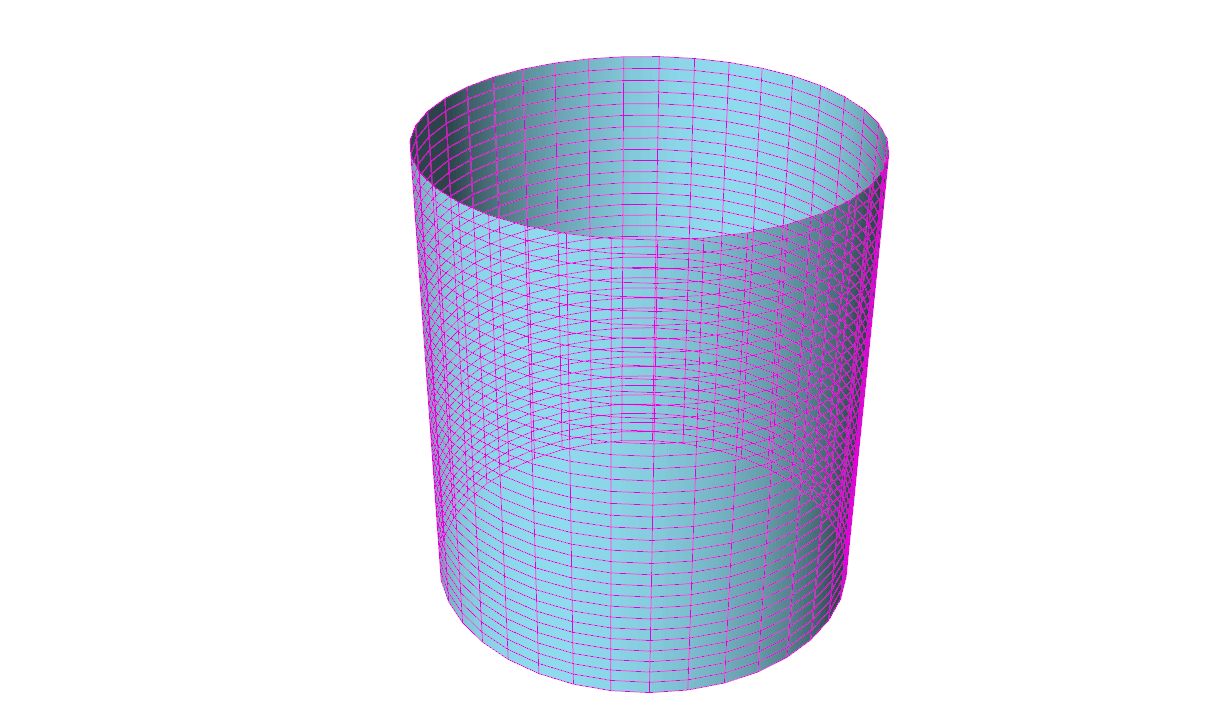
We can simulate surface tension by using a network of curves derived from a given shape. Applying varies material properties to the mesh results in a shape that can behaves like stretchy fabric or soap. Reducing the rest length of each of these curves (while keeping the edges anchored) makes them pull on all of their neighbours, resulting in a locally minimal surface.
Here are a few more examples of minimal surfaces you can generate using different frames (although I’d like stress that the possibilities are extremely infinite.) The first and last iterations may or may not count, depending on which of the many definitions of minimal surfaces you use, since they deal with pressure. You can read about it in much greater detail here: https://tinyurl.com/ya4jfqb2

Here we have one of the most popular examples of minimal surface geometry in architecture. The shapes of these domes were derived from a series of studies using clustered soap bubbles. The result is a series of enormous shells built with an impressively small amount of material.
Triply periodic minimal surfaces are also a pretty cool thing (surfaces that have a crystalline structure – that tessellate in three dimensions):
9.2 – Catenary Structures
Another powerful method of form finding has been to let gravity dictate the shapes of structures. In physics and geometry, catenary (derived from the Latin word for chain) curves are found by letting a chain, rope or cable, that has been anchored at both end, hang under its own weight. They look similar to parabolic curves, but perform differently.
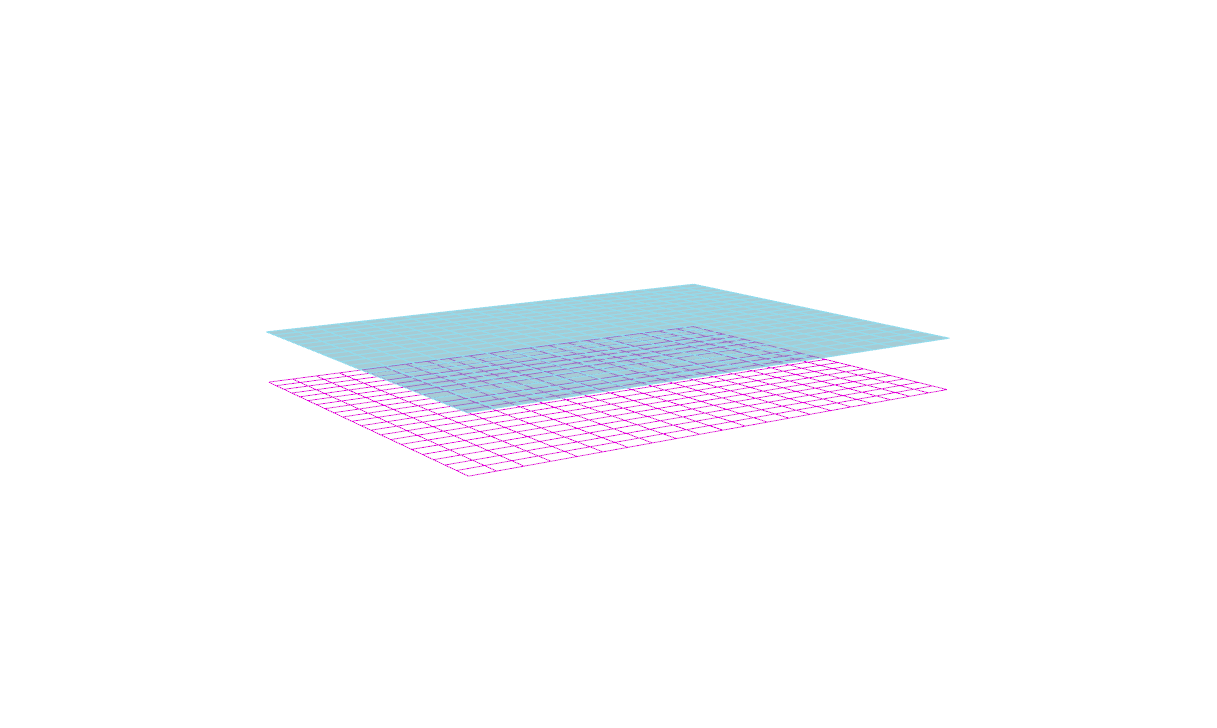
A net shown here in magenta has been anchored by the corners, then draped under simulated gravity. This creates a network of hanging curves that, when converted into a surface, and mirrored, ultimately forms a catenary shell. This geometry can be used to generate a gridshell that performs exceptionally well under compression, as long as the edges are reinforced and the corners are braced.
While I would be remiss to not mention Antoni Gaudí on the subject of catenary structure, his work doesn’t particularly fall under the category of gridshells. Instead I will proceed to gawk over some of the stunning work by Frei Otto.
Of course his work explored a great deal more than just catenary structures, but he is revered for his beautiful work on gridshells. He, along with the Institute for Lightweight Structures, have truly been pioneers on the front of theoretical structural engineering.
9.3 – Biomimicry in Architecture
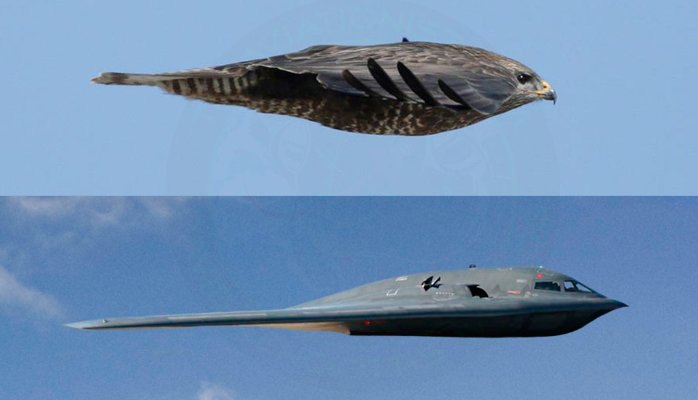
Frei Otto is a fine example of ecological literacy at its finest. A profound curiosity of the natural world greatly informed his understanding of structural technology. This was all nourished by countless inquisitive and playful investigations into the realm of physics and biology. He even wrote a series of books on the way that the morphology of bird skulls and spiderwebs could be applied to architecture called Biology and Building. His ‘IL‘ series also highlights a deep admiration of the natural world.
Of course he’s the not the only architect renown their fascination of the universe and its secrets; Buckminster Fuller and Antoni Gaudí were also strong proponents of biomimicry, although they probably didn’t use the term (nor is the term important.)
Gaudí’s studies of nature translated into his use of ruled geometrical forms such as hyperbolic paraboloids, hyperboloids, helicoids etc. He suggested that there is no better structure than the trunk of a tree, or a human skeleton. Forms in biology tend to be both exceedingly practical and exceptionally beautiful, and Gaudí spent much of his life discovering how to adapt the language of nature to the structural forms of architecture.
Fractals were also an undisputed recurring theme in his work. This is especially apparent in his most renown piece of work, the Sagrada Familia. The varying complexity of geometry, as well as the particular richness of detail, at different scales is a property uniquely shared with fractal nature.
Antoni Gaudí and his legacy are unquestionably one of a kind, but I don’t think this is a coincidence. I believe the reality is that it is exceptionally difficult to peruse biomimicry, and especially fractal geometry, in a meaningful way in relation to architecture. For this reason there is an abundance of superficial appropriation of organic, and mathematical, structures without a fundamental understanding of their function. At its very worst, an architect’s approach comes down to: ‘I’ll say I got the structure from an animal. Everyone will buy one because of the romance of it.”
That being said, modern day engineers and architects continue to push this envelope, granted with varying levels of success. Although I believe that there is a certain level of inevitability when it comes to how architecture is influenced by natural forms. It has been said that, the more efficient structures and systems become, the more they resemble ones found in nature.
Euclid, the father of geometry, believed that nature itself was the physical manifestation of mathematical law. While this may seems like quite a striking statement, what is significant about it is the relationship between mathematics and the natural world. I like to think that this statement speaks less about the nature of the world and more about the nature of mathematics – that math is our way of expressing how the universe operates, or at least our attempt to do so. After all, Carl Sagan famously suggested that, in the event of extra terrestrial contact, we might use various universal principles and facts of mathematics and science to communicate.
Developing Space-Filling Fractals
Delving deeper into the world of mathematics, fractals, geometry, and space-filling curves.
Foreword
4.0 Classic Space-Filling
4.1 Early Examples
In 1890, Giuseppe Peano discovered the first of what would be called space-filing curves:

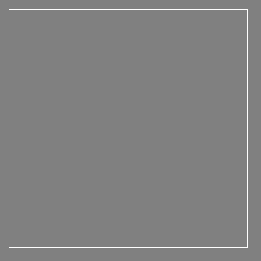
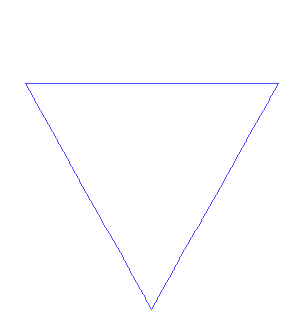

4.2 Later Examples
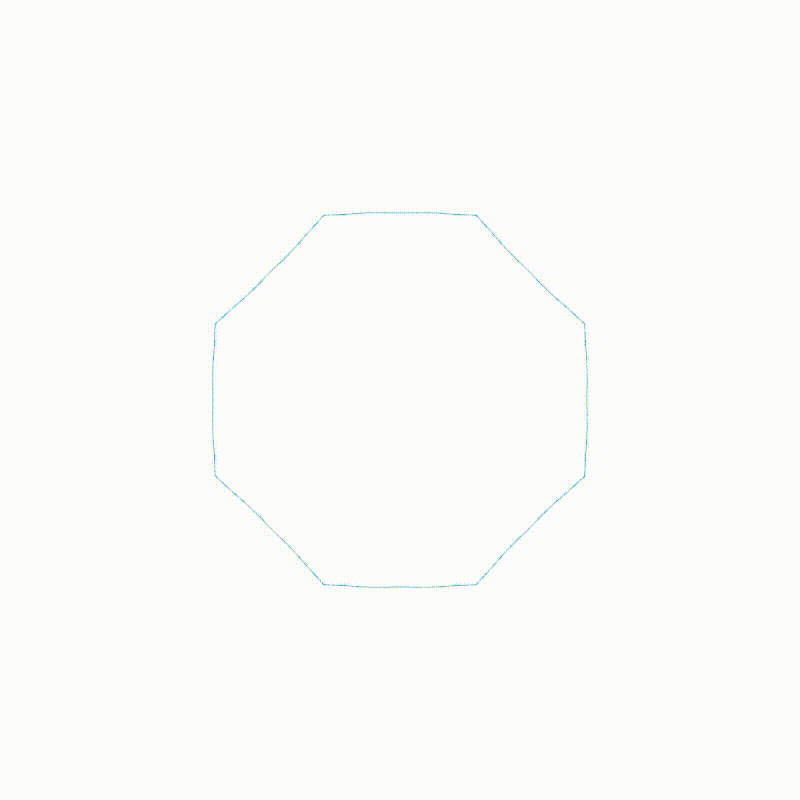
On A Strange Note:

5.0 Avant-Garde Space-Filling
5.1 The Traveling Salesman Problem
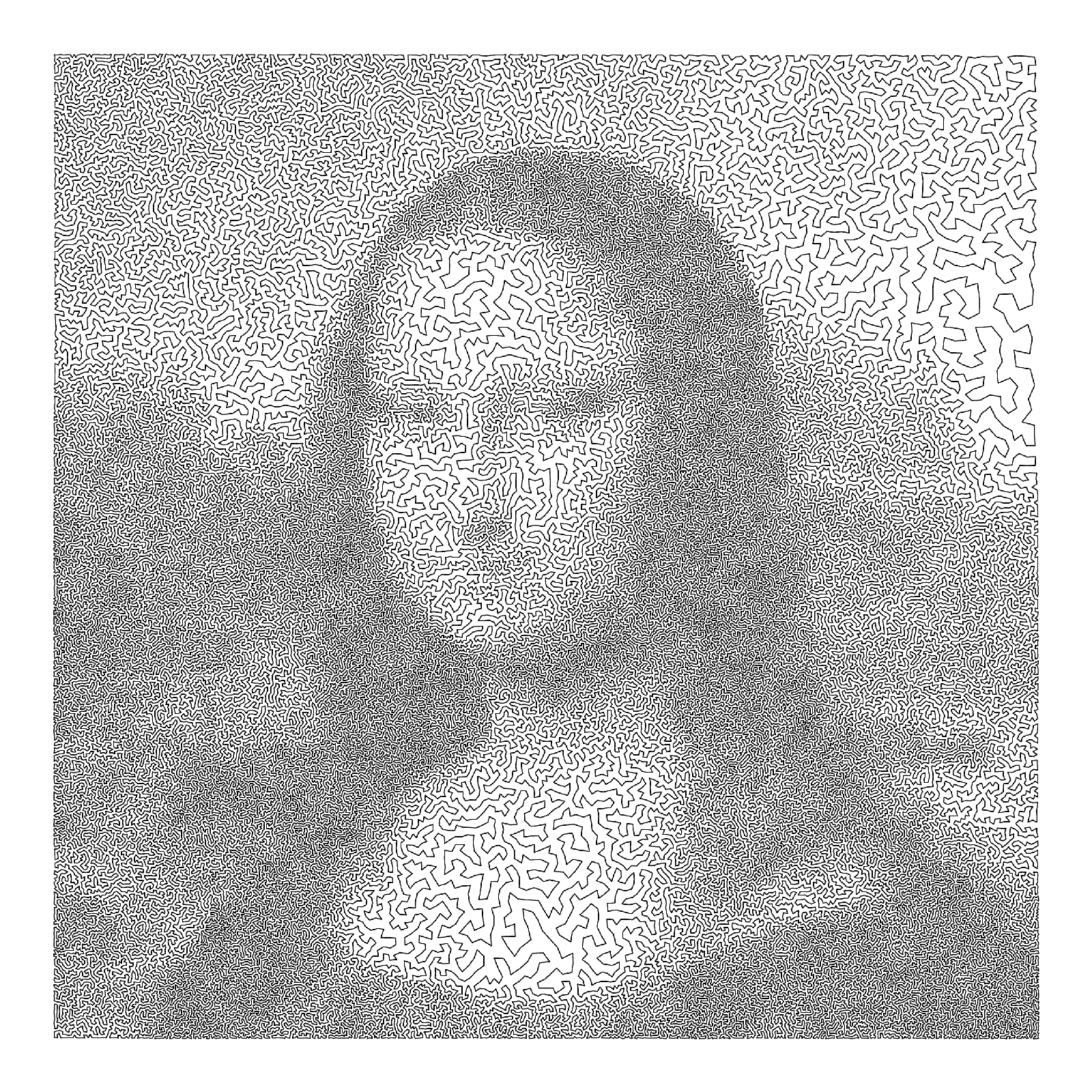
5.2 Differential Growth
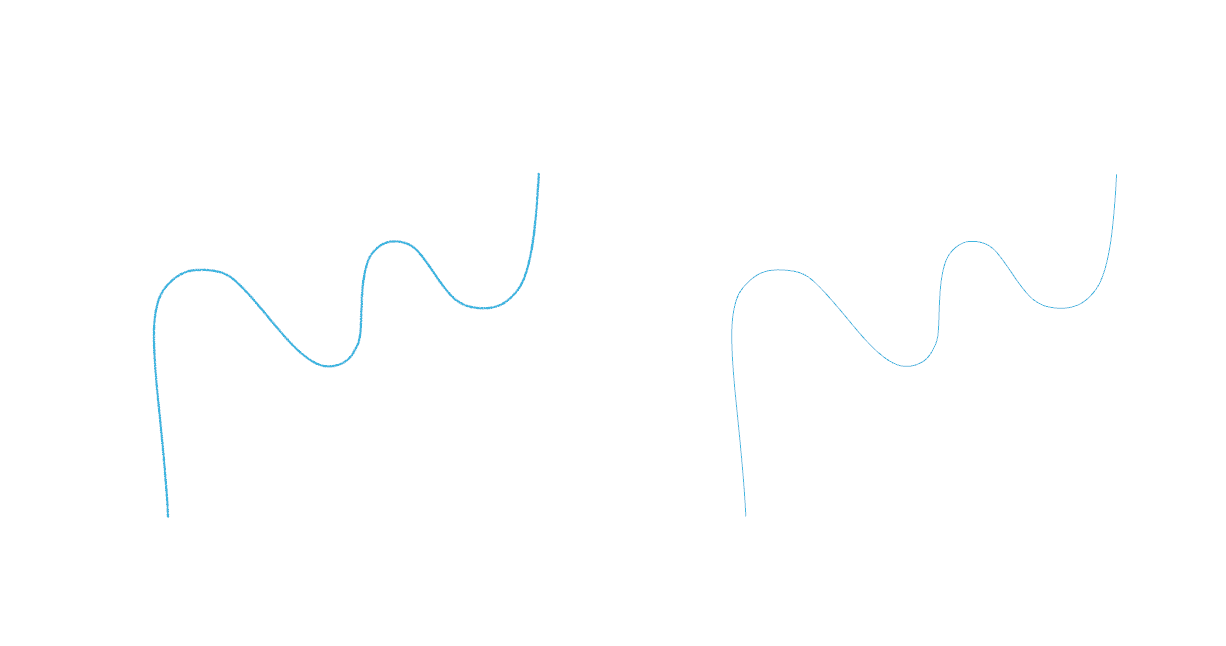
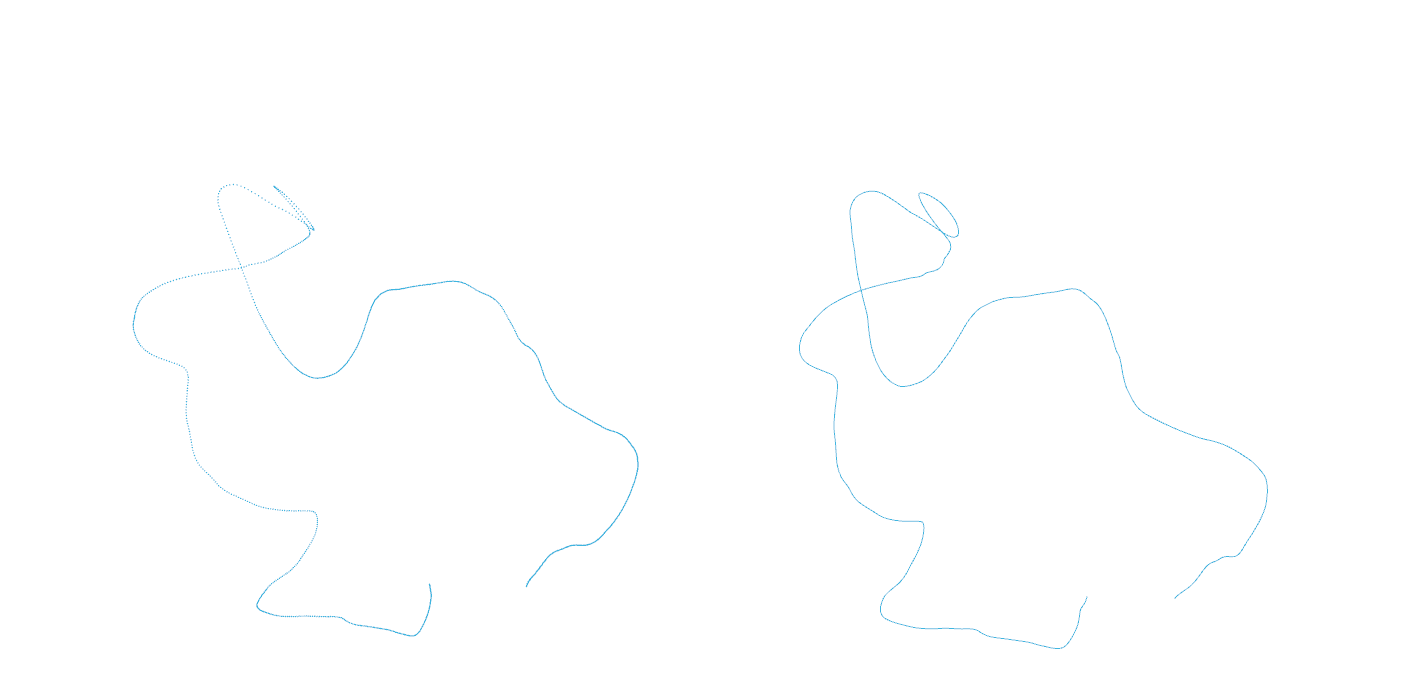
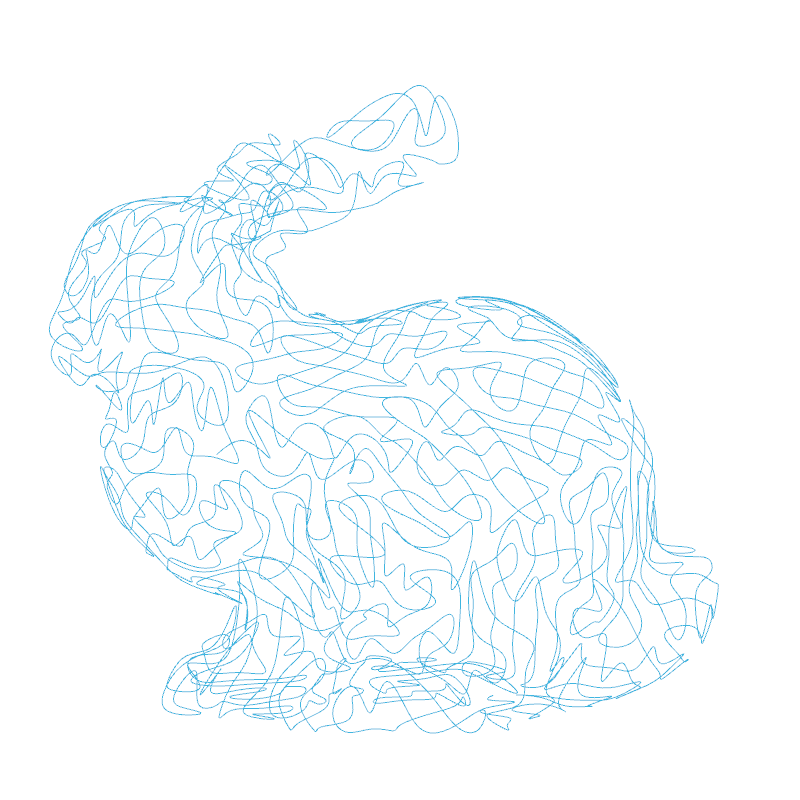


6.0 Developing Fractal Curves
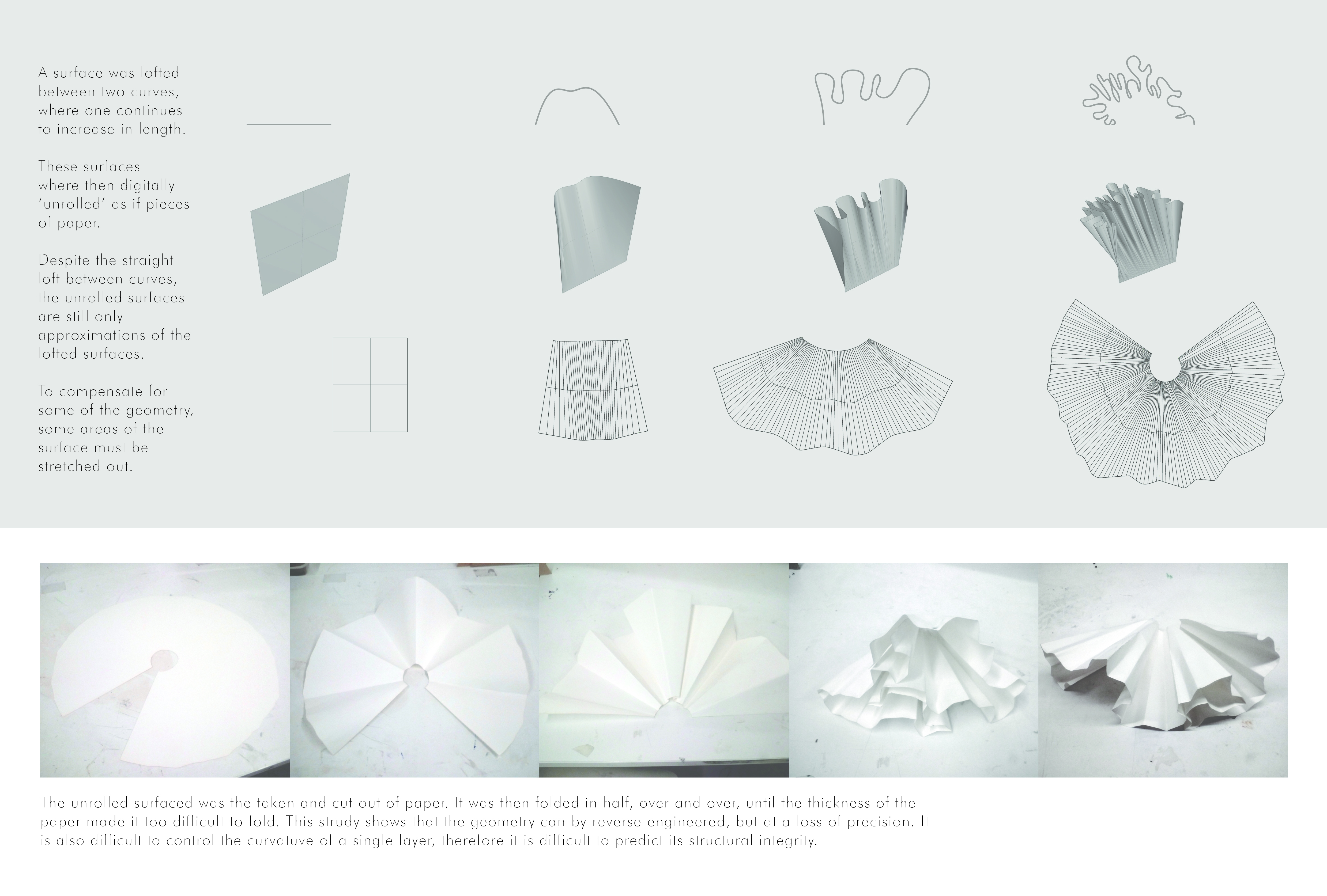
6.1 Dragon’s Feet
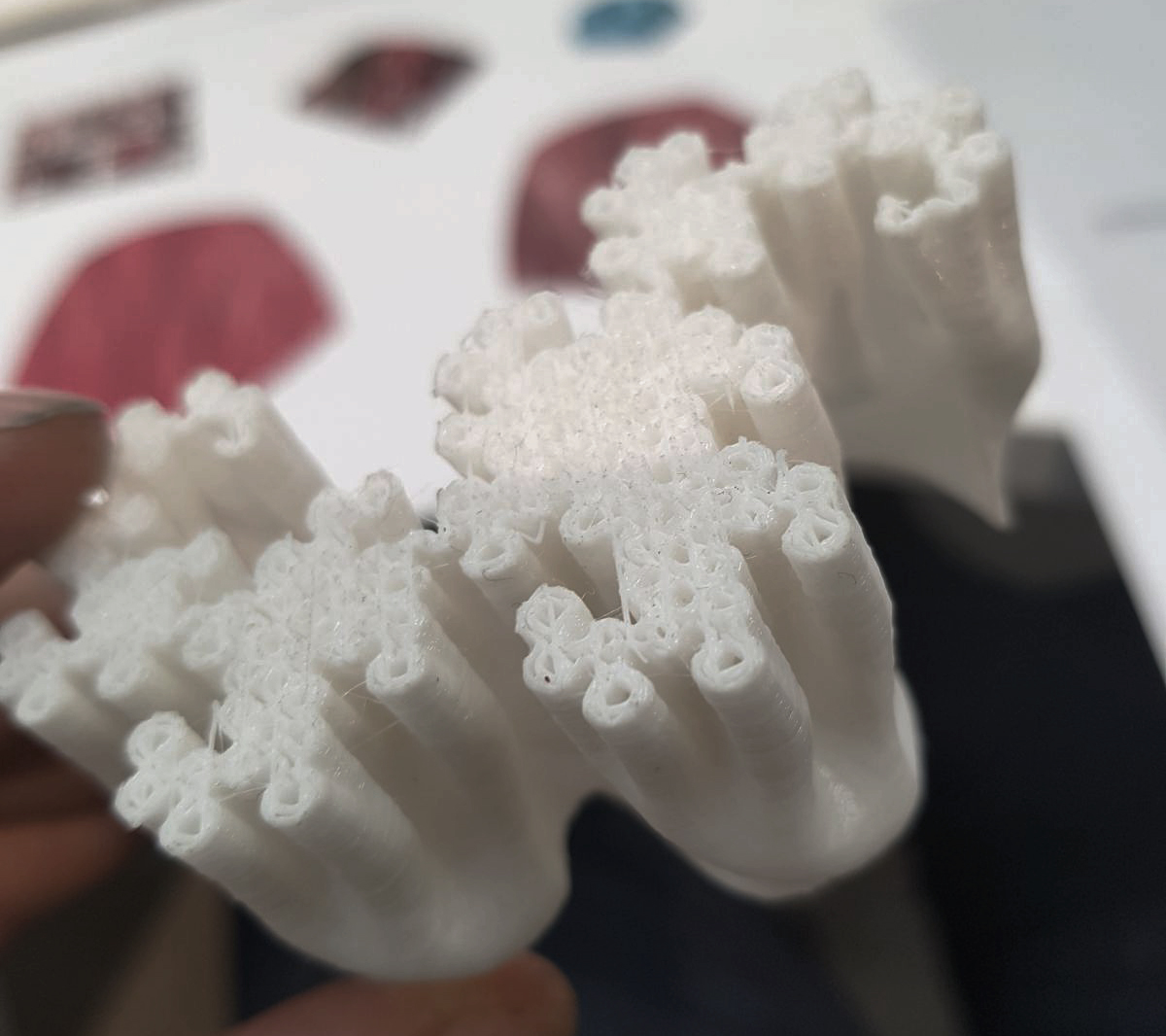
6.2 Hilbert’s Curtain
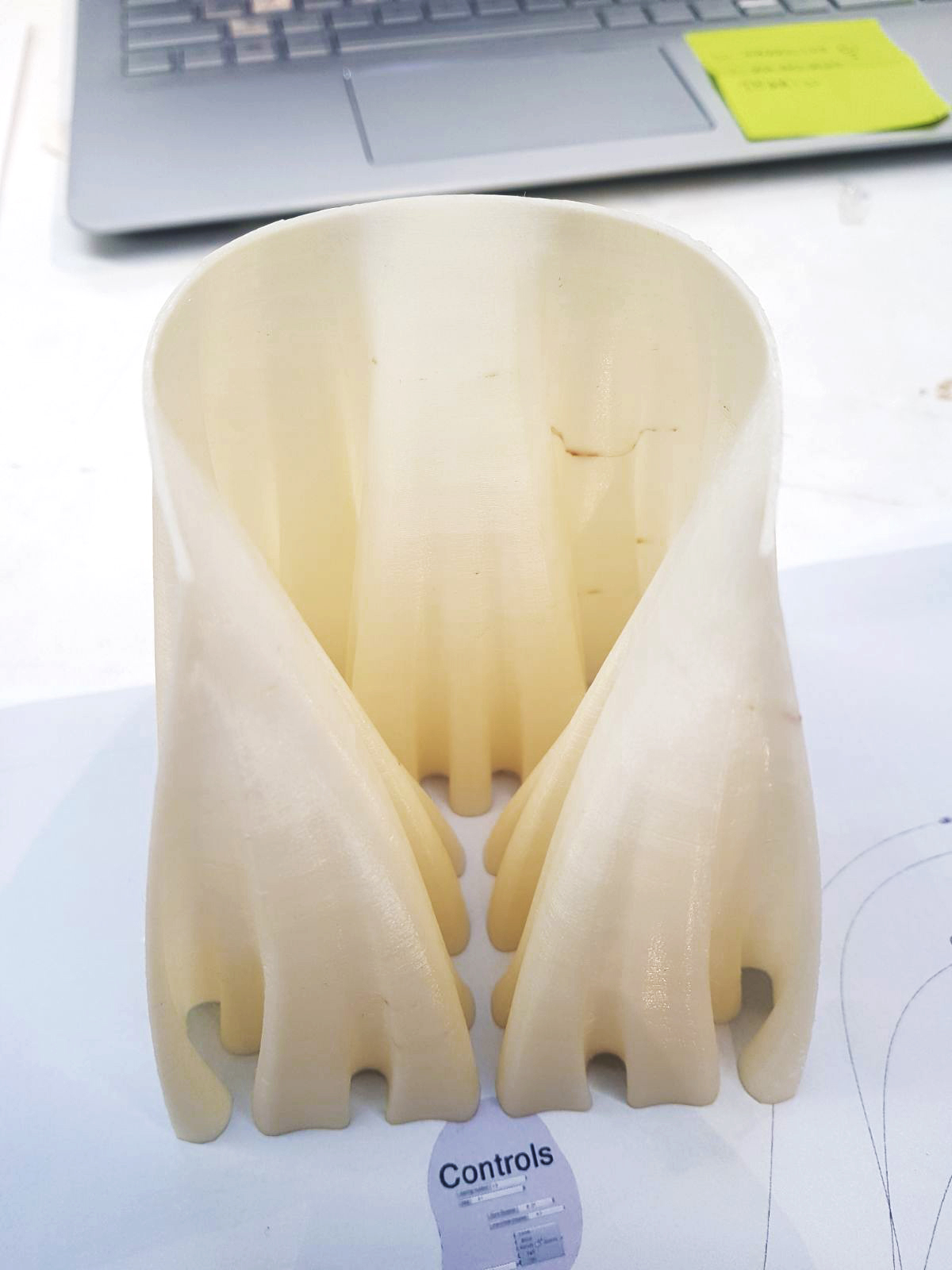
6.3 Developing Whale Curve
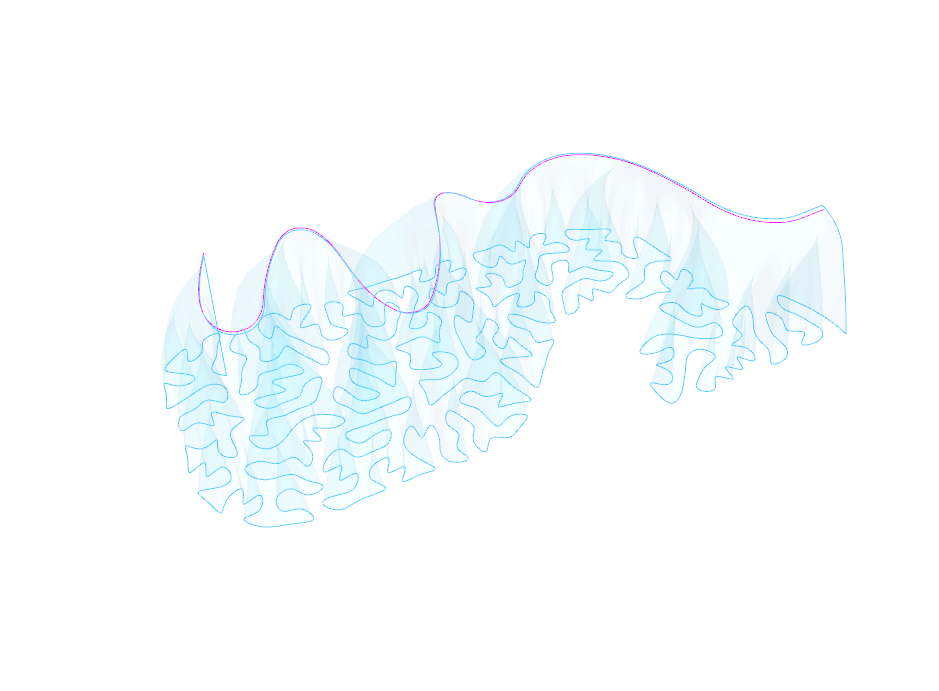
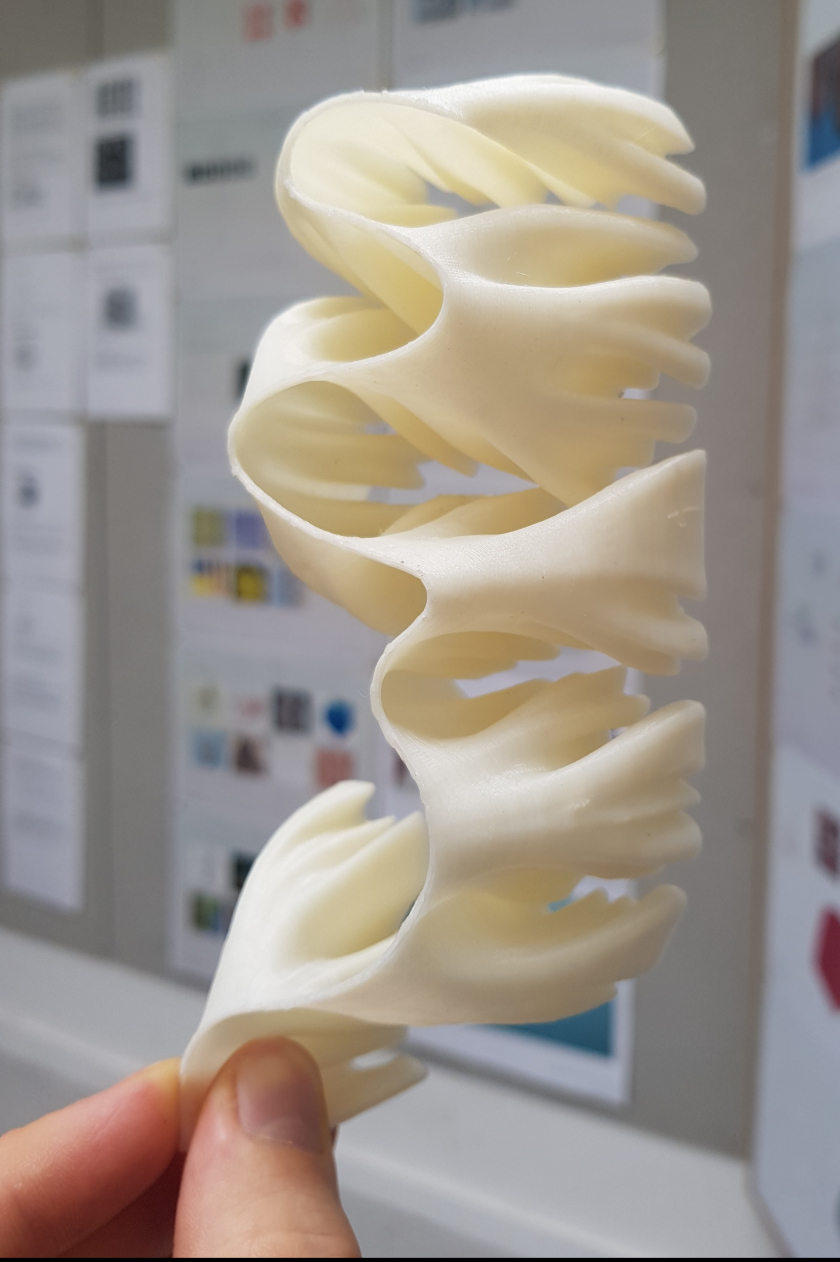
The Wishing Well
something caught in between dimensions – on its way to becoming more.
Summary
The Wishing Well is the physical manifestation, a snap-shot, of a creature caught in between dimensions – frozen in time. It is a digital entity that has been extracted from its home in the fractured planes of the mathematical realm; a differentially grown curve in bloom, organically filling space in the material world.
The notion of geometry in between dimensions is explored in a previous post: Shapes, Fractals, Time & the Dimensions they Belong to
Description
The piece will be built from the bottom-up. Starting with the profile of a differentially grown curve (a squiggly line), an initial layer will be set in pieces of 2 x 4 inch wooden studs (38 x 89 millimeter profile) laid flat, and anchored to the ground. Each subsequent layer will be built upon and fixed to the last, where each new layer is a slightly smoother version than the last. 210 layers will be used to reach a height of 26 feet (8 meters). The horizontal spaces in between each of the pieces will automatically generate hand and foot holes, making the structure easily climbable. The footprint of the build will be bound to a space 32 x 32 feet.
The design may utilize two layers, inner and out, that meet at the top to increase the structural integrity for the whole build. It will be lit from within, either from the ground with spotlights or with LED strip lights following patterns along the walls.

Ambition
At the Wishing Well, visitors embark on a small journey, exploring the uniquely complex geometry of the structure before them. As they approach the foot of the well, it will stand towering above them, undulating organically across the landscape. The nature of the structure’s curves beckons visitors to explore the piece’s every nook and cranny. Moreover, its stature grants a certain degree of shelter to any traveller seeking refuge from the Playa’s extreme weather conditions. The well’s shape and scale allows natural, and artificial, light to interact in curious ways with the structure throughout the day and night. The horizontal gaps between every ‘brick’ in the wall allows light to filter through each layer, which in turn casts intriguing shadows across the desert. This perforation also allows Burners to easily, and relatively safely, scale the face of the build. Visitors will have the opportunity to grant a wish by writing it down on a tag and fixing it to the well’s interior.
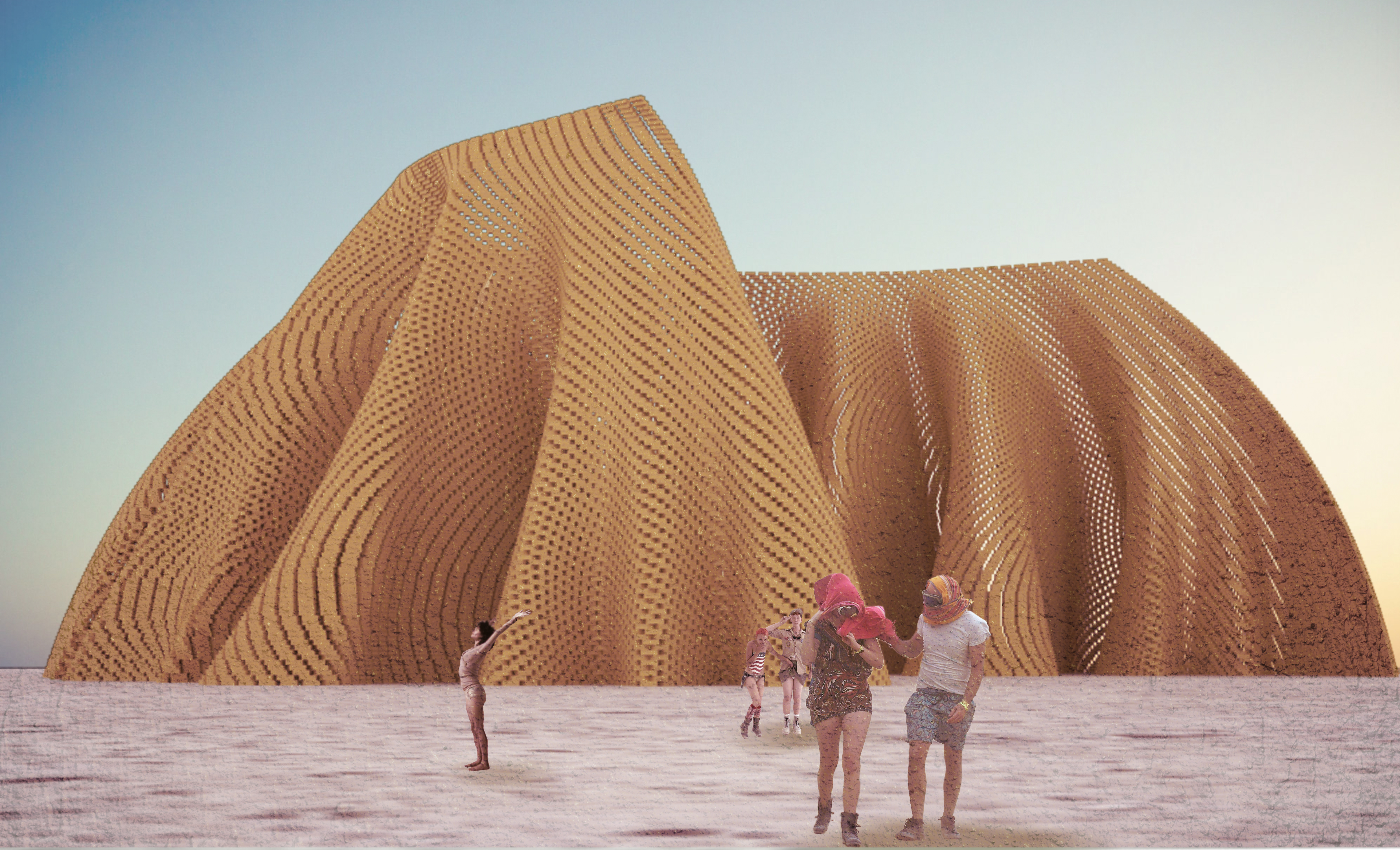
Philosophy
If you had one magical (paradox free) wish, to do anything you like, what would it be?
Anything can be wished for at the Wishing Well, but a wish will not come true if it is deemed too greedy. Visitors must write their wish down on a tag and fix it to the inside of the well. They must choose wisely, as they are only allowed one. Additionally, they may choose to leave a single, precious, offering. However, if the offering does not burn, it will not be accepted. Visitors will also find that they must tread lightly on other people’s wishes and offerings.
The color of the tag and offering are important as they are associated with different meanings:
- ► PINK – love
- ► RED – happiness, joy, success, good luck, passion, vitality, celebration
- ► ORANGE – change, adaptability, spontaneity, concentration
- ► YELLOW – nourishment, warmth, clarity, empathy, being free from worldly cares
- ► GREEN – growth, balance, healing, self-assurance, benevolence, patience
- ► BLUE – conservation, healing, relaxation, exploration, trust, calmness
- ► PURPLE – spiritual awareness, physical and mental healing
- ► BLACK – profoundness, stability, knowledge, trust, adaptability, spontaneity,
- ► WHITE – mourning, righteousness, purity, confidence, intuition, spirits, courage
The Wishing Well is a physical manifestation of the wishes it holds. They are something caught in between – on their way to becoming more. I wish for guests to reflect on where they’ve been, where they are, where they are going, and where they wish to go.
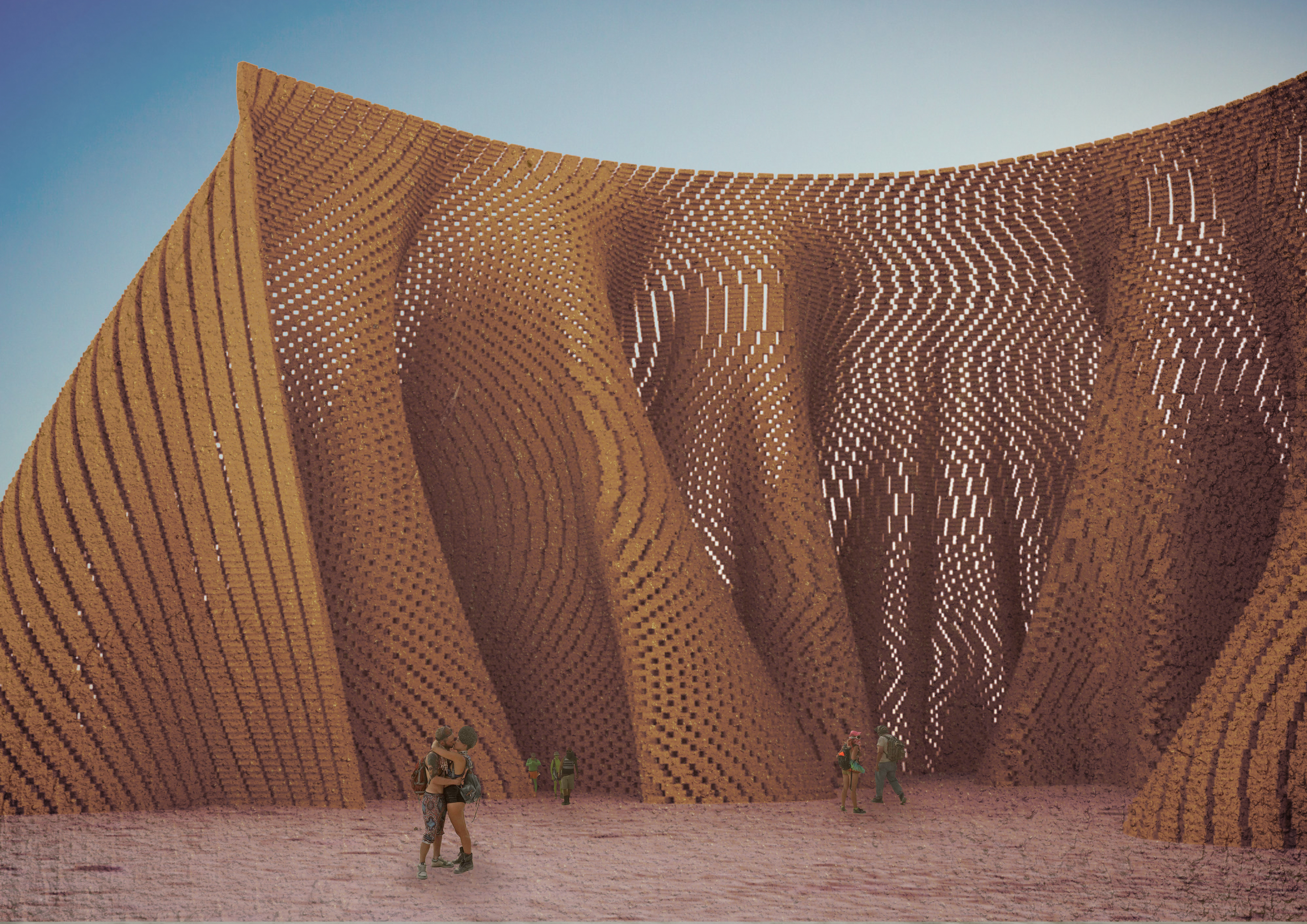
Babels
Symbol- Language and Sound into System
Language has a strong symbolic meaning to the mankind. It is not just a sound but with meanings which then allows to self-express, communicate and inspire. The mechanism of the sound system of languages is translated into visually represented geometries using Chladni’s Law.

3-Dimensional computer generated Chladni Patterns
When the frequencies increase, the pattern gets more complicated.
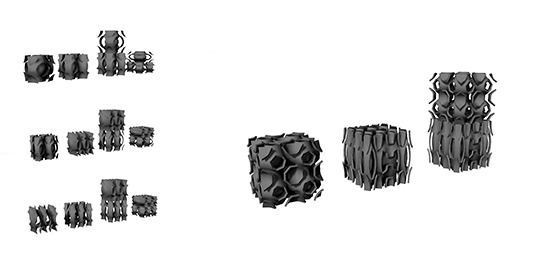
 Tower of Babel – The origin of different languages
Tower of Babel – The origin of different languages
“Come, let’s make bricks and bake them thoroughly. […] Come let us build ourselves a city, with a tower that reaches to the heavens, so that we may make a name for ourselves and not be scattered over the face of the whole earth.” (Genesis 11:3~4)
(The Tower of Babel by Pieter Bruegel)
It is the story from the Bible but also architectural structure found in Mesopotamia Civilisation – called Ziggurat. It was made of asphalt and baked bricks with total dimensions of 90m x 90m, 90m high. This is equivalent 30th floor building.
The united humanity spoke a single language and agreed to build a city and a tower that is ‘tall enough to reach heaven’. God found such behaviour as rude and disrespectful. He confounded man’s speech so that they could no longer understand each other.
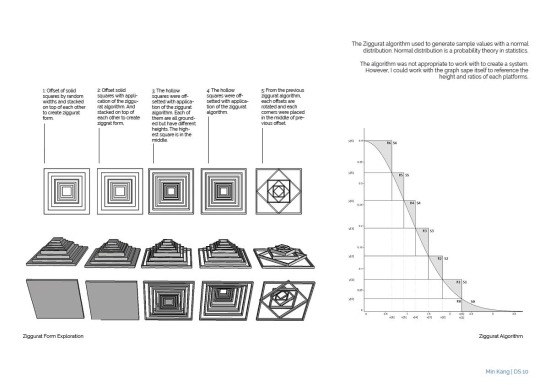
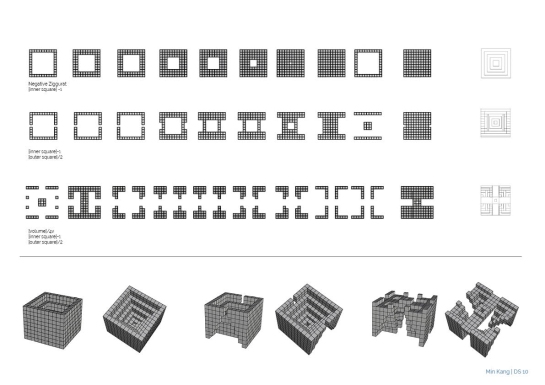
Concept Development through systematic studies of Ziggurat
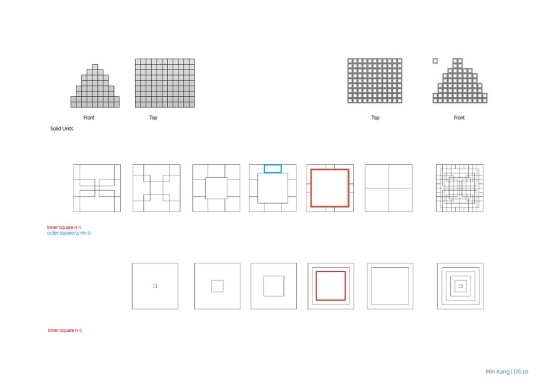
The frequency and nodes of the word is analysed and recreated as two geometrical forms. They are proportioned according to the Ziggurat Algorithm ratio and timber pieces are stacked up vertically reaching the highest deck at 8m above. The structure encourages to climb complex geometry.
While reaching the top, less intense the space becomes. The LEDs are placed underneath the timber pieces which are concentrated on the top of the tower and scattered following the central void of the structure. Lights illuminate with the voice reactive sensor placed at the top of the tower.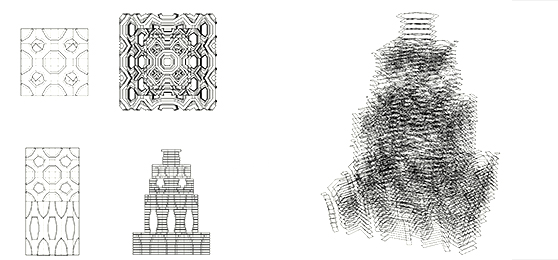
Human always wanted to reach higher points either physical or spiritual. The height of architecture symbolised one’s power and control. This can be observed from the tower of Babel and continues in architectural history. Such expression of the desire of heights lead to competition of building higher structure.
High rise buildings were often found in religious architecture where they had few typical characteristics. First, it was the only tower to observe your land and the only tower which can be seen from everywhere in town. It has a visual meaning that the land within the perspective is the land within control. Second, religious architecture often had music instruments embedded within. This represented the control of the land where music reaches. And finally, high-rise tower was a representation of the centre of universe and sacred space in religious term. The tower, architecture of height is a spatial symbol of man’s deep desires.
The ritual is all about finding the true desire of your own. This begins with constructing the tower where the ritual follows the biblical story of Babel. Climbing up 8m high construct is a challenge then the climbers are rewarded with the beautiful panoramic view of Black Rock city. The climbers will also interact with the installation by continuously stacking up the Babels with anything they can find. Eventually it will deform from the original shape. Then the Babels will be the collective symbol of the Burners’ pure desire.
Celestial Field
Whatever your creed your reliance on the sun is unquestionable.
We have worshipped it as a God.
Spent lifetimes studying it through science.
Yet human hands will never touch its surface.
Celestial Field brings our sun to the Playa for us to dance in its glory.
Triggering our own solar flare.
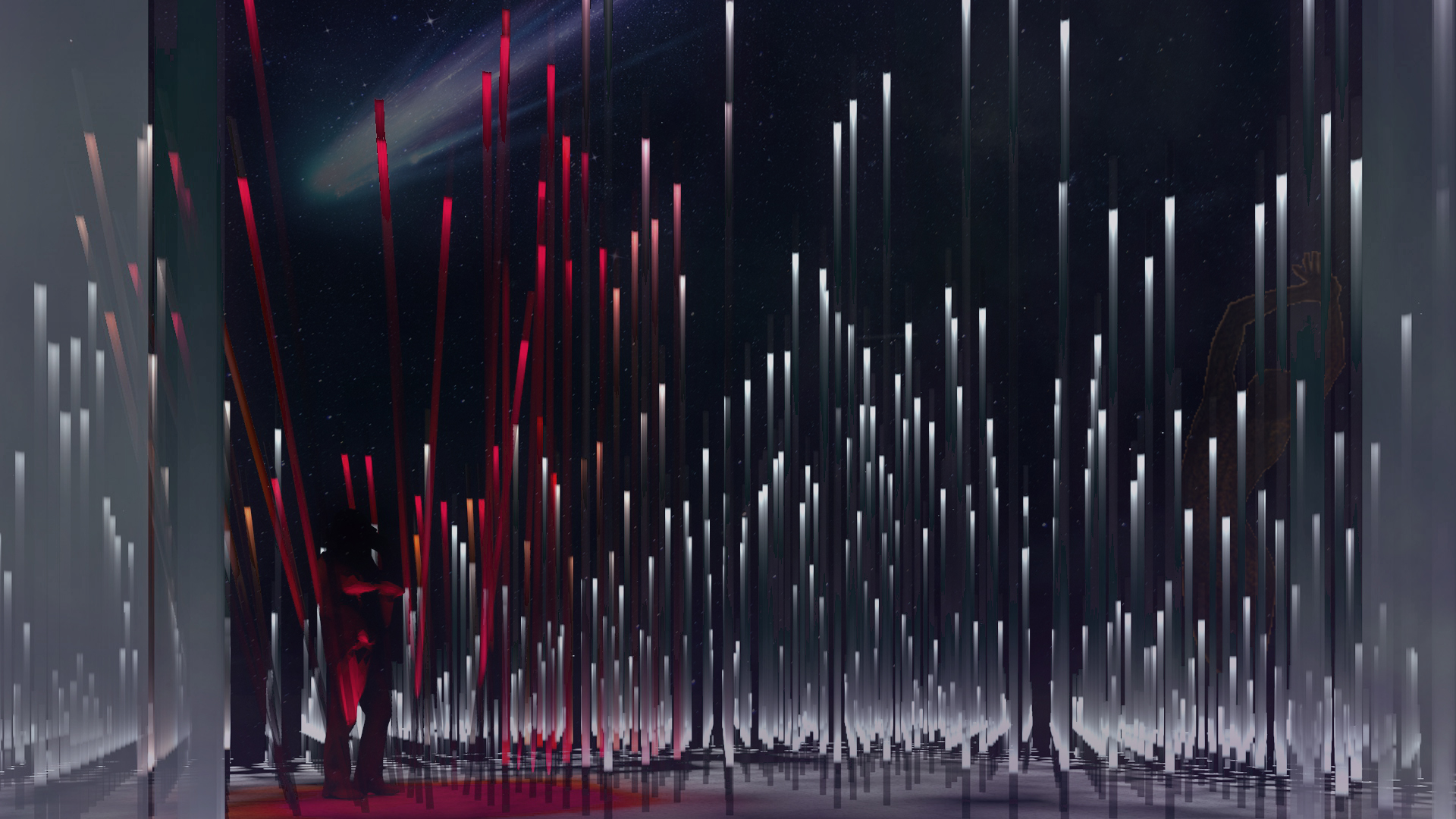
From the dawn of time the sun has been a constant in human life. It has been central to the beliefs of nearly every civilisation throughout history. What was once an astrological wonder sustaining life; dictating when to plant and harvest our crops; evolved into a god and deity, woven into the stories and teachings of nearly every culture, from the Egyptians to the Ancient Greeks and even Christianity.
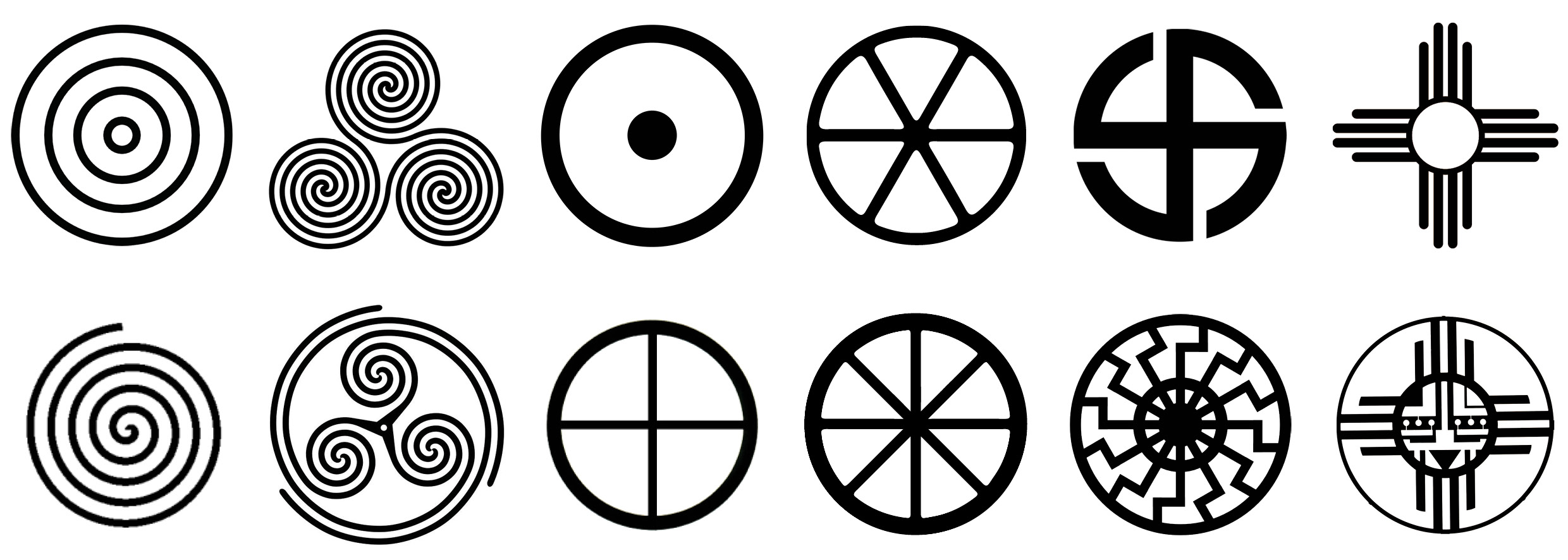
The oldest man-made structures in the world have resounding astrological connections to both the sun and constellations, covered in carvings they unquestionably align to major astrological events.
Newgrange in Boyne Valley, Ireland, thought to be built in 3500BC, has a tomb in which sits a stone basin lit by a single beam of light at sunrise on the winter solstice.
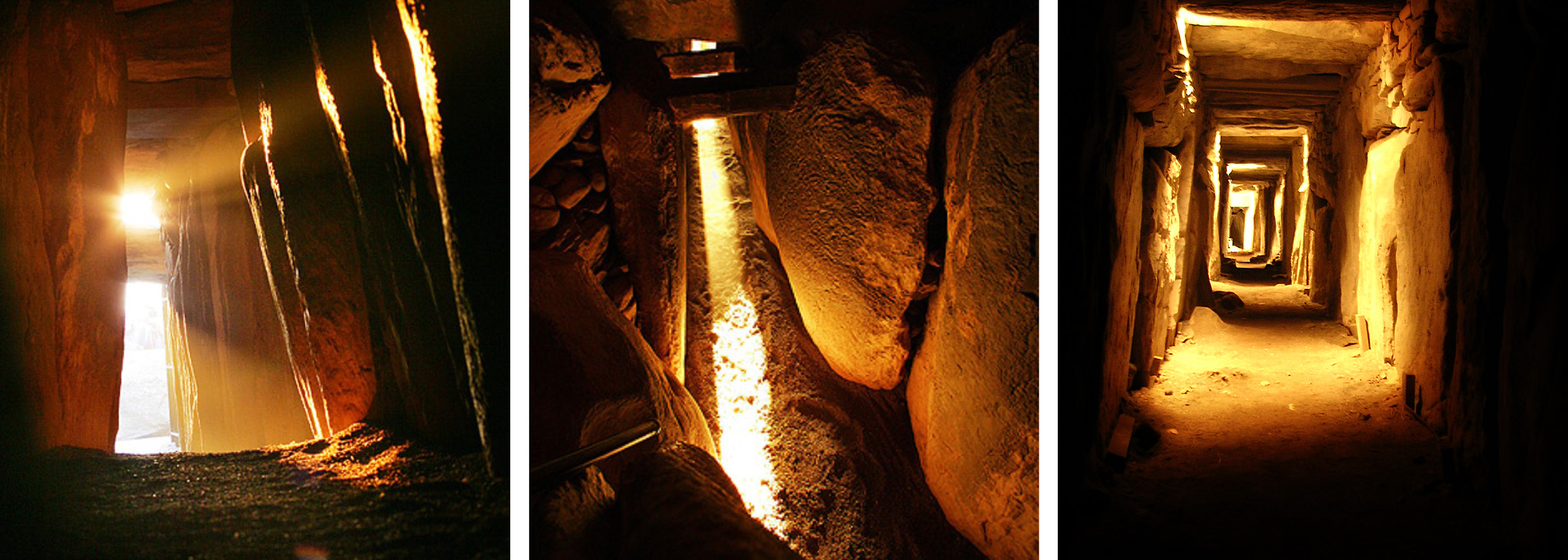
The Egyptians, Greeks, and Christians have all referenced the sun within their religion and beliefs.
The Egyptians in 3000BC had Ra, the Greeks in 400BC believed Helios to be God of the sun, and Christians have often depicted Jesus in front of what is thought by many to be the solar cross.
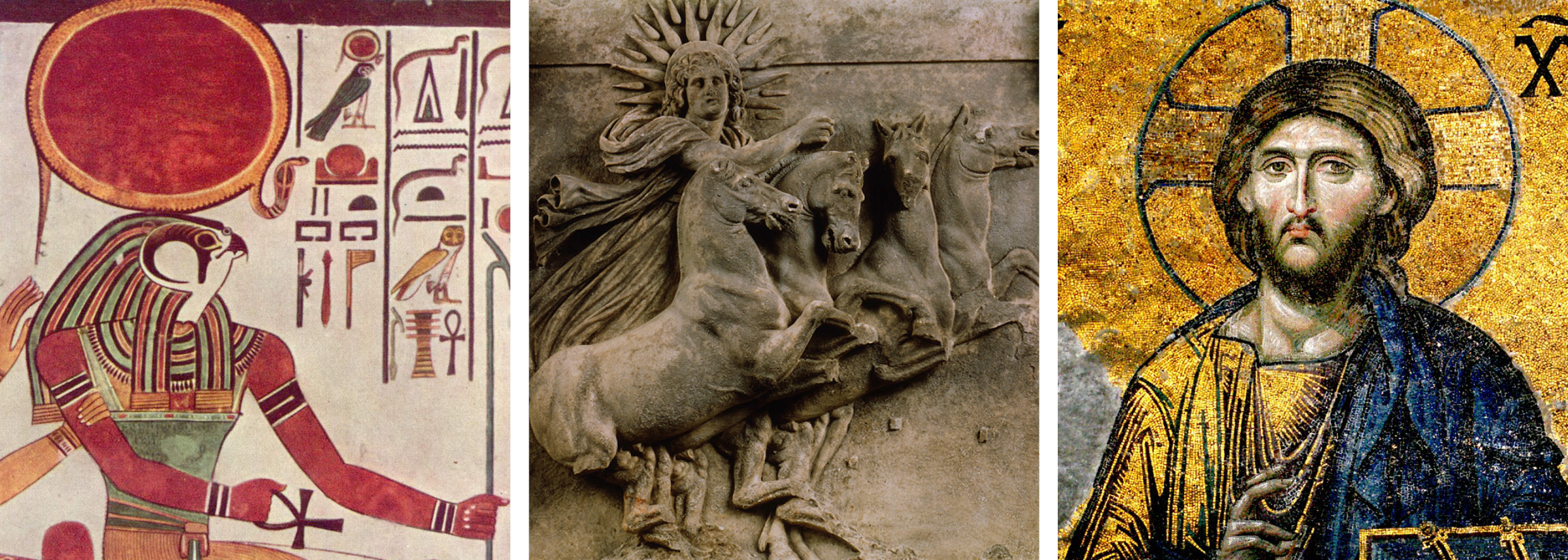
In the past the sun has been depicted as a 2Dimensional disk of light travelling across the sky before dying only to be reborn at sunrise.
The Ancient Greeks believed Helios to be the personification of the sun. A man with a many rayed crown of light, pulling the sun across the open sky with a horse drawn chariot. The Helios named after the Greek god has been used and adapted through the ages, with one of the most recognisable iterations being the logo of global corporation BP which symbolises “a number of things – not least the greatest source of energy … the sun itself..” – bp.com
This once celestial being has now become a tangible thing. Through advances in our technological and scientific capability we have gained an understanding of the suns chemical make-up, uncovering many of its secrets from sun spots to solar flares. Although we have developed an increased understanding of the forces driving the sun, it is still no more accessible to us mere humans than on the first day on earth remaining an impenetrable sphere in the sky only to viewed from a far.
The suns surface has taught us much. Galileo’s sun spot diagrams unknowingly demonstrated the unique fluidity of the suns chromosphere. Further study of these sun spots and magnificent solar flares proved that the surface of the sun is covered in billions of interlaced magnetic fields all interacting together to form the whole. When these fields cross swirling plasma burst in an instance out into the corona bringing with it immense light displays that can be seen on earth as the aurora.

In an age where endless streams of newfound knowledge are accessible with the touch of a finger – it is easy to lose our sense of innocent amazement and unquestioning awe. We have a constant need for explanation of why and how phenomena exist, no longer blindly excepting their beauty and revelling in it.
The indescribable beauty of these gigantic magnetic fields can often be lost and forgotten in the mundane when scaled down to earthly objects. Viewing them at a micro scale allows us to connect with their other-worldly nature.
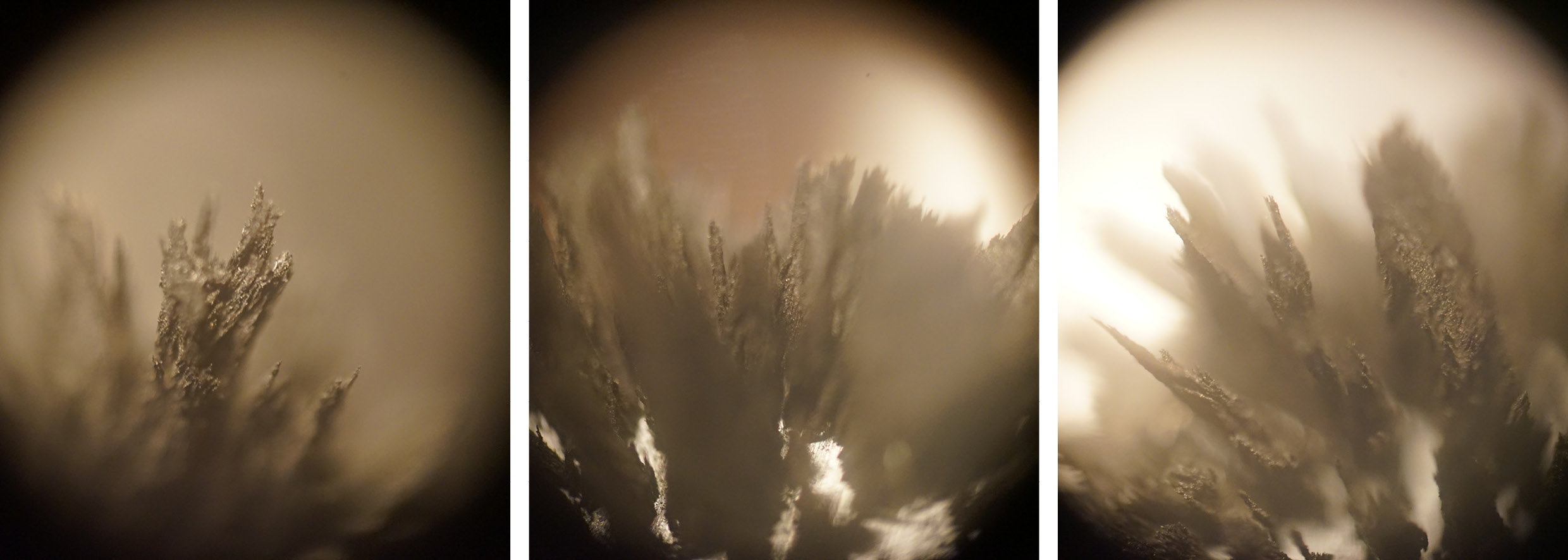
Science has taught us how a magnet attracts and repels enabling use in industry, medicine and everyday life. And as our knowledge expands, we move from child to adulthood and our desire to play diminishes – burdened by explanations and reasoning; we are no longer in awe of our ability to make metal move without laying hands on it. It has become the norm and the expected, it is no longer ‘magic’.
Life should be fun and full of mesmerising moments. Our increased knowledge should enable and enhance our experience of ‘magic’ not hinder it.
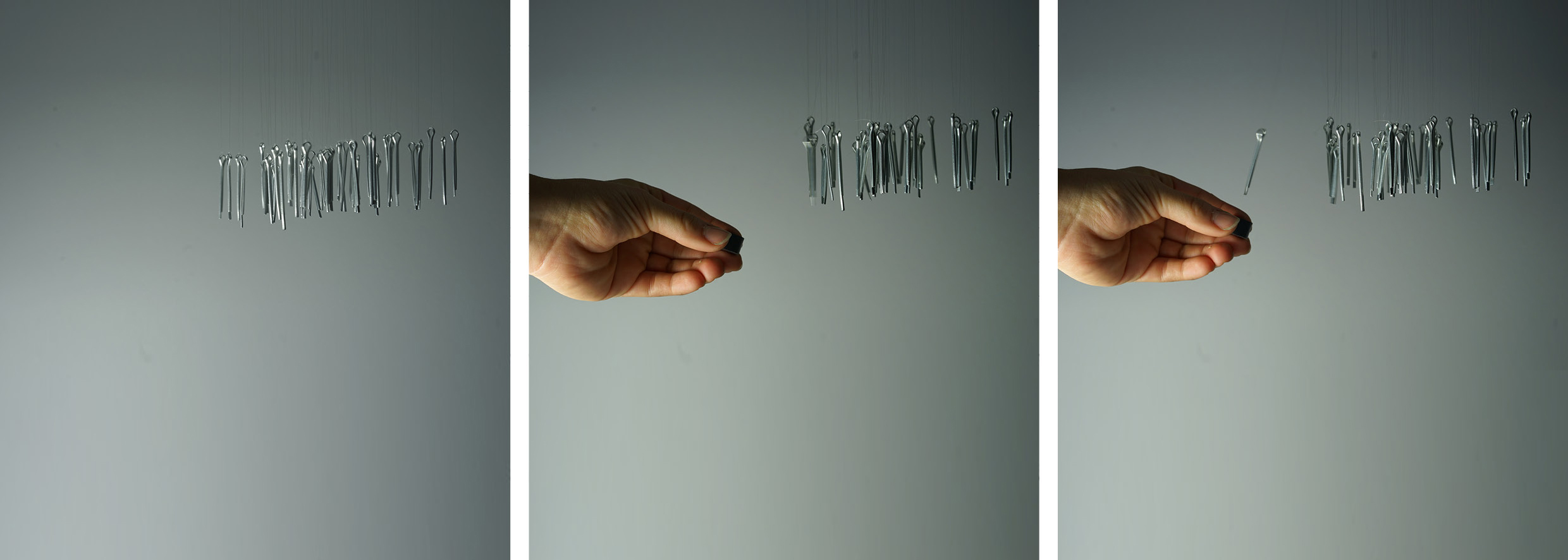
Celestial Fields captures the unexplainable wonderment the sun once held and makes it accessible through modern mediums, combining two worlds; science and enchantment, imbedding them on the Playa at Black Rock City, Nevada, for people to explore and lose themselves in.
Thousands of swaying rods made of tubes of one-way mirror form an undulating field, rising high above your head, and falling like the plasma pulled in all directions by the phenomenal magnetic forces found on our sun.
By day a field of mirrors reflect and intensify the suns natural beauty and power. Creating a maze of ever changing light to explore, push through and play within. At sunset everything transforms. The field morphs, bursting into a sea of glowing beams reacting to movement and mimicking the fluid, almost pulsing nature of the suns corona.
Like the chromosphere, magnetic fields have informed density and pattern, creating patches of pure brightness and areas as dark as sunspots. With each rod built on a spring loaded base it can be pushed a manipulated, enabling you to forge your own path through the densest areas of Celestial Field, parting rods like magnets repelling polarised iron.
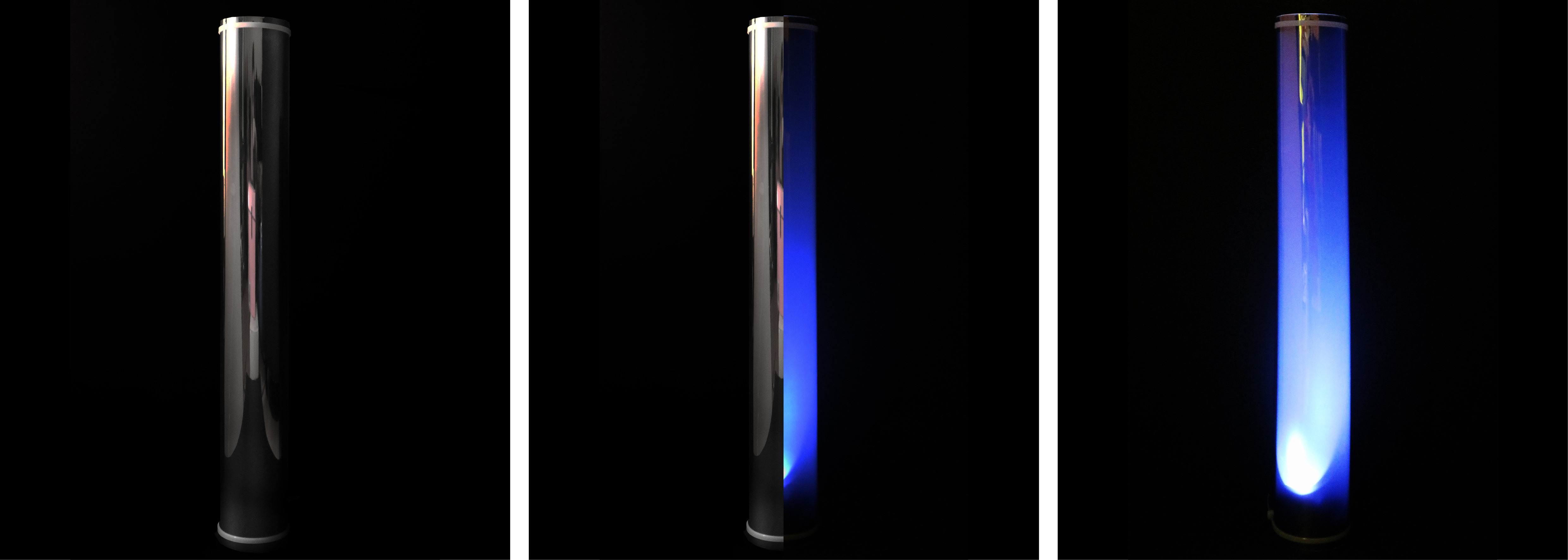
Movement through the sprung rods creates interest not only for the participants but also onlookers. During daylight hours people weaving in and out can be seen across the playa through the constant glinting of the sun on the reflective rods. An ever changing shimmer, like sunlight dancing across water in the distance, drawing people in from all directions out of wonder and intrigue.
Once the sun has set the lights come on, and the show only gets better. The rods now glow and pulse, changing colour, transforming the world around them – each equipped with a sensor so as to react to movement as people push past; creating tracks of swirling light shifting like the turbulent surface of the sun. Areas of intense and overwhelming light can occur when people team together to trigger a cluster of rods forming a concentration of light evocative of a solar flare.
The sun is not solely about light, with it comes inevitable darkness. Shadows too have been used throughout time as a symbol in opposition to that of the sun; and in this instance the areas of shadow formed in the magnetic layout create areas of calm within the thrill of the lights where one can sit and ponder everything from the dessert to the sky and the sun that brings life to earth.
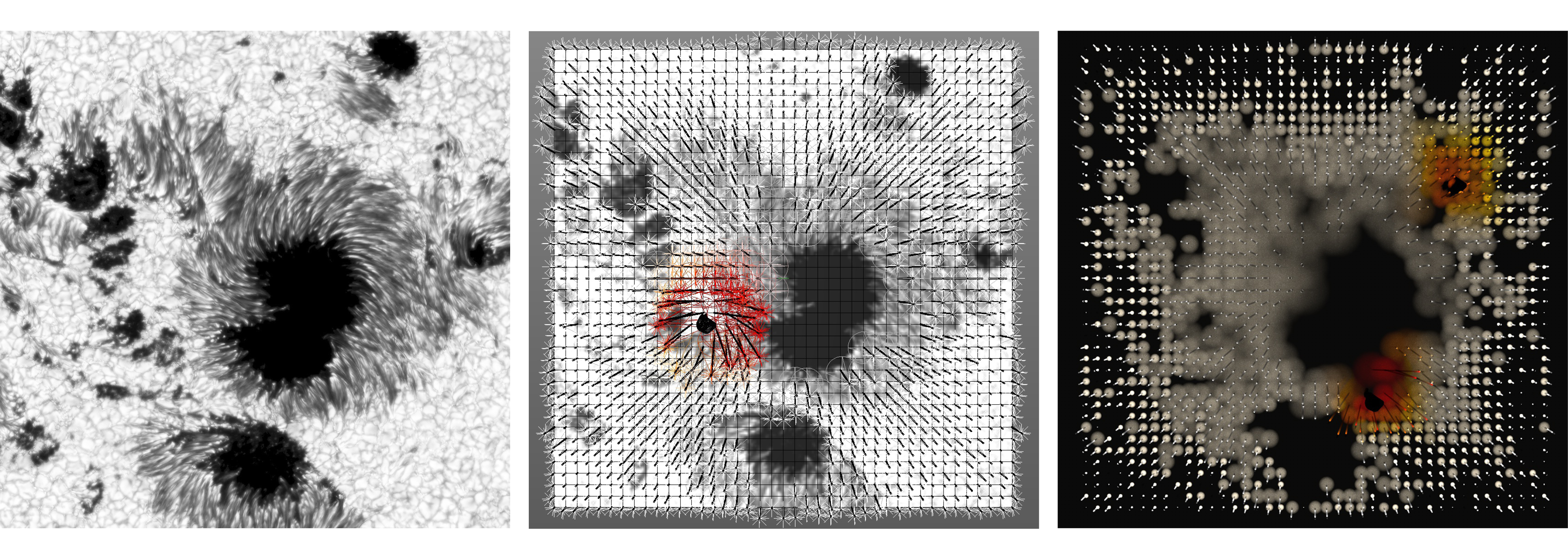
What was once worshipped as a distant god and celestial being can now exist on the surface of the earth as a Celestial Field in Nevada. The sun has risen and set, bringing with it heat and light; powering life on earth since the dawn of time, a focus of incomprehensible wonder and fascination for each and every culture across the globe.
Celestial Field intends to reignite our faith in the intangible, while showing us there are powers and beauty still to be found in the modern world.
Adaptable Hypars
An exploration of the simplest Hyperbolic Paraboloidic ‘saddle’ form has lead to the development of a modular system that combines the principles of the hypar (Hyperbolic Paraboloid) and elastic potential energy.
A hyperbolic paraboloid is an infinite doubly ruled surface in three dimensions with hyperbolic and parabolic cross-sections. It can be parametrized using the following equations:
Mathematical: z = x2 – y2 or x = y z
Parametric: x(u,v)=u y(u,v)=v z(u,v)=uv
The physical manifestation of the above equations can be achieved by constructing a square and forcing the surface area to minimalise by introducing cross bracing that has shorter lengths than the square edges.


A particular square hypar defined by b = n * √2 (b=boundary, n=initial geometry or ‘cross bracing’) thus constricting the four points to the corners of a cube leads to interesting tessellations in three dimensions.


Using a simple elastic lashing system to construct a hypar module binds all intersections together whilst allowing rotational movement. The rotational movement at any given intersection is proportionally distributed to all others. This combined with the elasticity of the joints means that the module has elastic potential energy (spring-like properties) therefore an array of many modules can adopt the same elastic properties.


The system can be scaled, shaped, locked and adapted to suit programmatic requirements.
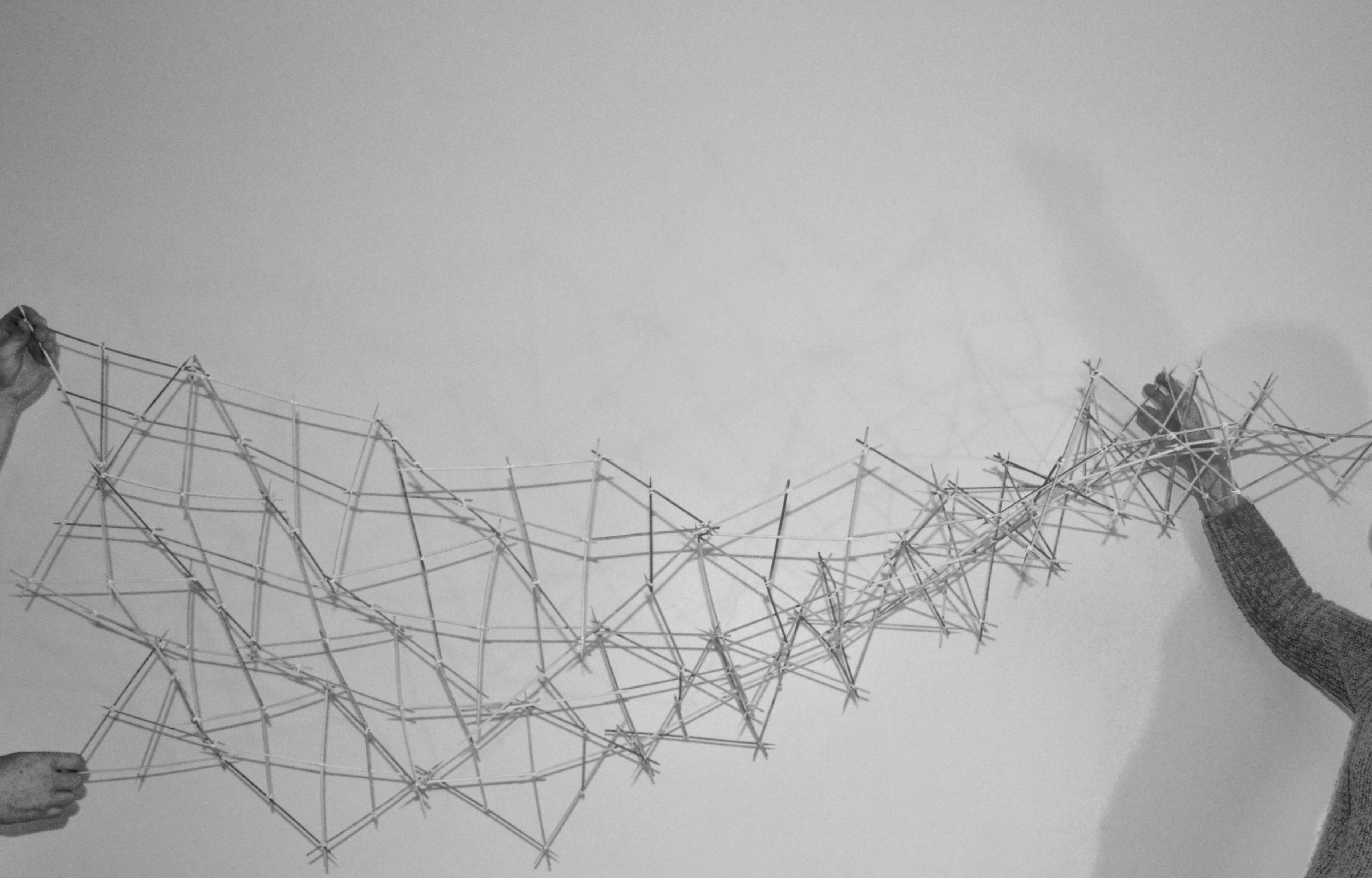
Vulcan’s Flame
A geometric wall of fire burning on the sands of the Black Rock Desert. This immobile blaze stands as an edifice to Burning Man’s original figurehead. A burning yet fireless wall of plywood and acetate that can be encountered, entered and sheltered in.
This sculpture stands as an abstract image of flames sent by Vulcan the Roman God of fire, an emblem of the festival’s name. Created from a series of plywood shapes and acrylic, Vulcan’s Flame is a blazing wall of light and colour. The structure is created to both imitate and juxtapose chemical fire, sharing real fires beauty but opposing its destructive tendencies. The sculpture is designed as a wall of shelter, behind which burners can be shielded from the desert’s unforgiving sun.
Born from Ancient Egyptian ‘Cairo tiling’, the sculpture is created from morphing polyhedra. The lowest section of the fire is created from cubes which gradually deform into rhombic dodecahedrons – a cubist interpretation of a flames movement. Internally every shape is painted to mimic fire’s bright hues and coloured acetate panels within the wall will project red and yellow tones onto the surrounding desert floor. At night internal spotlights will illuminate the entire structure, creating a glowing inferno of colour. These lights will flicker to create the illusion of movement.
Visually the main structure consists of three main forms;
- The outer zone: the sparse cubic section of the sculpture, representing the hottest part of a flame, the region of complete combustion
- The middle zone: this is the central area in which the cubic deformation begins to occur.
- The inner zone: this is the coolest space, the most densely packed red area of the sculpture. Burners can crawl into this space – sheltered by four layers of dodecahedrons.
Physical Description:
Vulcan’s Flame is a long, low plywood structure, the installation is the geometric interpretation of a flame, a curving sculpture of deforming polyhedral that slowly transform from a cube to a rhombic dodecahedron. The sculpture is created from 55 plywood polyhedra constructed from hand cut plywood boards and secured with cable ties. Internally each shape is painted using natural, organic paints, as the shapes change their internal colour alters from yellow to red. Coloured acetate panels in the uppermost faces of each shape will mirror the shapes internal hue, these panels will allow sunlight through during the day casting beautiful coloured shadows on the desert floor. At night the sculpture will be lit internally with fluctuating spot lights, this will create the illusion of flickering movement. The acetate panels will be secured with nails.
The structure sits on a base of 23 plywood shapes, secured to the ground with rebar stakes. The sculpture is very stable as the base is the widest section, the rest of the sculpture tapers away towards the top. Each new shape rest on the 4 corners of the shapes below, bolted through the vertices and then secured with rope. The final and highest rhombic dodecahedron is stabilised with a steel column. The highest point on the entire structure is just over 11 feet above ground level and consists of 4 stacked shapes. A full sized version of one of the shapes has already been constructed and load tested confirming that it can support human weight, all of the cable ties securing the structure will be meticulously rubbed down to ensure they are not sharp.
The sculpture curves in a gentle arc – creating a central area of shelter from the wind and sun. At ground level Burners can crawl inside the structure and rest in it’s shady, tinted interior.
Inspired by previous research of pyritohedrons, these structures are an addition to a series of other models based on polyhedral deformation. Previous models have experimented with density, altering colour and infill panels.
I N T I
Philosophical Statement:
Inti: The Incan Sun God, his face portrayed as a gold disk from which rays and flames extended. Inti is the Sun and controls all that implies: warmth, light and sunshine. During the festival of Inti Ramyi, held during the Summer Solstice, Inti is celebrated with much drinking, singing and dancing – special statues are made of wood are burned at the end of the festival. This sculpture is an extended physical manifestation of this; decadent ritualism and a spiritual experience.
Inti incorporates 288 petals are self-assembled into 12 concentric rings, with each petal representing the hours of the day and each ring every month of the year. These are held together using mirror polished circular brackets, designed to catch the light and reflect circles of sunlight around the structure interior. Inti’s focus is the sunrise; as the sun rises on the playa, Inti is designed to catch the light at this precise moment and funnel through the piece, enveloping and bathing the burners inside with it’s warmth and spirit.
Timber Wave by Henry Turner
Philosophical Statement:
‘Timber-Wave’; a plywood instillation emerging and crashing on to the desolate Black Rock Desert. This breaking wave a remnant of the retreating Quinn River, draws on imagery of both waves and dunes provoking thoughts of the original Burning Man Beach Parties and surfing counter culture. Simultaneously the design evokes concepts of the Silk Road as a mirage of a giant wave appearing from across the playa to be discover by wondering burners.
The design of the Timber Wave was driven by creating an interactive environment. In daytime, people are encourages to climb and search between the interwoven plywood structure. Open sun soaked communal areas create areas for group contemplation. Solitary areas for single travelers have also been designed as places of refuge from the intense sun, wind and dust storms hoping to encourage serendipity. At night the wave truly come alive as a monument to the sea. Bathed in varying blue tones of color the spectacular structure is a mysterious beacon within the dark playa.
Physical Statement:
‘Timber-Wave’ structure consists of 3 layers of 12 intersecting plywood ribbons. Each ribbon consists of a varying number of water bent plywood components con-caving and con-vexing together forming a rigid series of tensioned and compressed sections. The result is a homogeneous structure creating a beautiful ergonomically sized spaces. Each ribbon a series of circular penetrations in the form of an abstracted water pattern. Creating foot and hand holes for climbing as well as allowing dramatic shadows to be cast throughout the structure and across the playa. At night the penetrations allow the lighting of the instillation to spill across the playa and between the layers of the structure.
1:20 Scale Model

